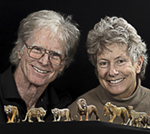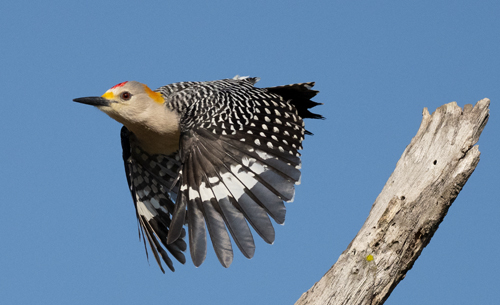
Golden-fronted Woodpecker,
South Texas Photo Tour
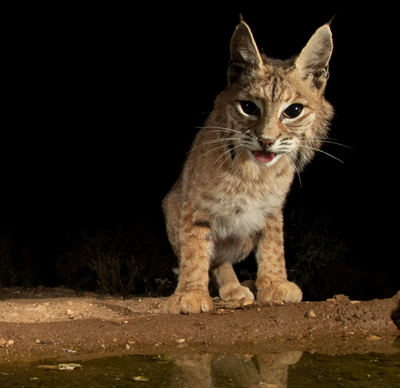
Bobcat at waterhole,
Ron Niebrugge's photo site
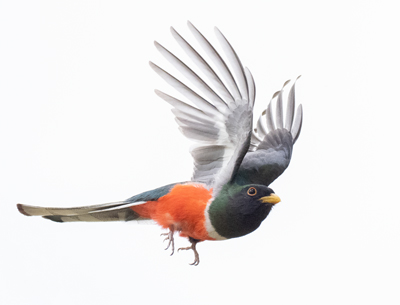
Elegant Trogan,
Santa Rita Mts - Arizona Hummingbirds and Bats Photo tour
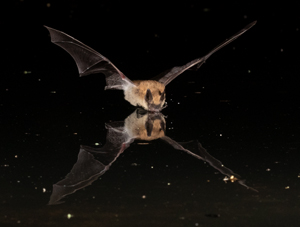
The Bat Shoot - AZ
Two Photo Tours and several Scouting Trips occupied our time in late April and early May, which included extremely productive shoots in southern Texas and in southern Arizona, where, sadly, we may have concluded our Arizona Hummingbird Photo Shoots. We've been doing Arizona's hummingbirds for thirty years, and in doing so, we've missed our Spring season here in Pennsylvania every year. Next year we'll miss it again, with our trips to Ecuador for hummingbirds, and the fantastic Galapagos Islands for its wildlife. The following year, if all goes as planned, we'll be home in Spring, to enjoy the changing of seasons for the first time in three decades!
Since pictures tell a thousand words, I'll be brief in the text, and instead I thought it might be more helpful to discuss some of the images that illustrate the report. So, here's the Reports:
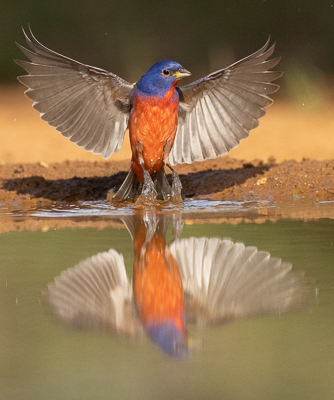 Texas Bird and Wildlife Photo Tour
Texas Bird and Wildlife Photo Tour
We visited two photo ranches, Laguna Seca and Santa Clara, for this tour. Although we've always included Santa Clara on our tours, this was the first time we visited Laguna Seca. We're extremely glad we did, as the landscape and wildlife there were different enough to make the two ranches distinct and well worth visiting.
We were extremely fortunate to have the owner of Laguna Seca join us for the shoot. His help in arranging props, and in predicting where a bird might land, was invaluable, and our time shooting with him was extremely enjoyable, too. Birds were are primary focus at Laguan Seca, and we did well with a wide assortment of south Texas species.
I also had a chance to set up for a Barn Owl nest, and that was a real adventure. I was planning to use a Range IR attached to my camera, intending to have the owl trip the beam and fire the camera. When a camera is attached to a beam, however, there is a lag time, and I'd have to guess how far an owl might travel after breaking the infrared beam before my camera actually fired. So .... while I was in one of the photo blinds I decided I'd be better off tripping a flash, with the camera shutter open as we do for our bat photography. After we were finished in the bird blinds I started setting up, discovering that in making my initial decision, I stupidly left the flash cable necessary for the alternative technique. Dusk was falling, and my flash cable was back at the hotel, about 25 minutes away. I decided to get it, and drove faster than I'd like to make the round trip in time for the owls. I made it, and the owls had not yet left the nest box for their night's hunting.
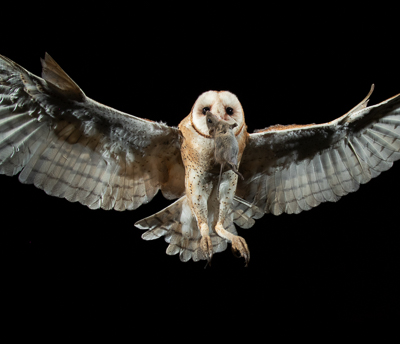
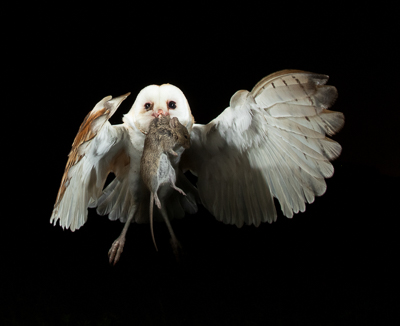
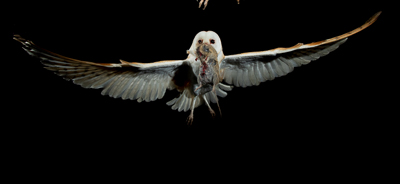
Here's what was involved in this shot: 4 Phottix Flashes with 1 Phottix Ares II
transmitter to fire the flashes; 4 8-foot tall Light Stands; 1 Really Right Stuff Groundpod for my Range IR infrared transmitter; 1 Really Right Stuff tripod and FH350 videohead for the camera; camera.
When a RangeIR is wired to the flashes there is no lag time, but the shutter must be open to record any flash triggered when an owl breaks the beam. I set the camera shutter for 30 seconds, assuming that an owl flying in to the nest box to feed its chicks would remain there longer than 30 seconds. This worked, although I did have one frame where the owl flew in with a rat and flew back out, creating a double image.
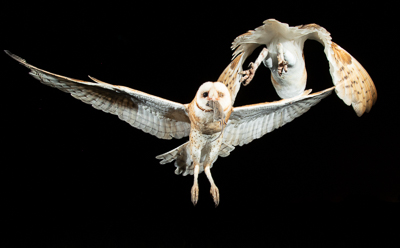
I had hoped to have more than one chance to film the owls but a horrific storm was brewing on the second night. Nonetheless, I felt pretty good about getting everything setup and going, despite losing more than one hour for a drive for a cable!
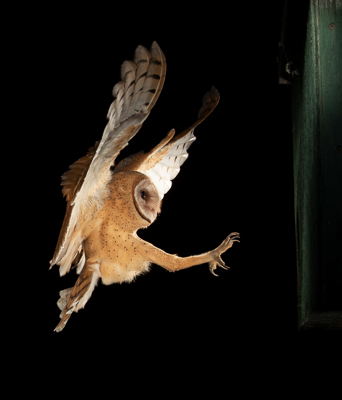 I had a chance at another nest, but unfortunately the Barn Owls had fledged. They were still using their nest box, but the adults were no longer feeding their babies inside the box. Instead, if they were feeding them at all, they did so on perches spread out across the scrub. For this setup I knew I wouldn't get birds flying in with food, and I hoped to get some shots as the birds left the nest box for their evening hunt or begging routine. Accordingly, I set up for a side view, but when I arrived to turn on the gear, all of the owls were out, flying about and enjoying the dusk. I hoped a bird might return, and set up in the same fashion I did previously. One bird flew in ... one shot.
I had a chance at another nest, but unfortunately the Barn Owls had fledged. They were still using their nest box, but the adults were no longer feeding their babies inside the box. Instead, if they were feeding them at all, they did so on perches spread out across the scrub. For this setup I knew I wouldn't get birds flying in with food, and I hoped to get some shots as the birds left the nest box for their evening hunt or begging routine. Accordingly, I set up for a side view, but when I arrived to turn on the gear, all of the owls were out, flying about and enjoying the dusk. I hoped a bird might return, and set up in the same fashion I did previously. One bird flew in ... one shot.
Since Mary and I have switched to Olympus we really hadn't had a great chance to use ProCapture, the absolute game-changer for action photography. Our shoots at both ranches changed that, and we had multiple opportunities to catch birds in flight, revealing poses we'd have missed with traditional gear. ProCapture, with the flagship M1X camera, records 35 frames prior to the frame where the camera actually fires, doing so in a loop that continually rewrites over the 35th frame as the newest frame is recorded. Images are not written to the SD card until you actually fire off a shot, so you're not eating up SD card memory. The result, instead of having the tail-end of a bird or nothing at all in the frame, we were recording the entire take-off, picking the shot that best illustrated the behavior.
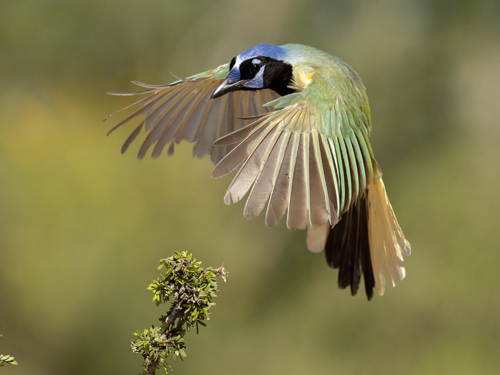
Green Jay
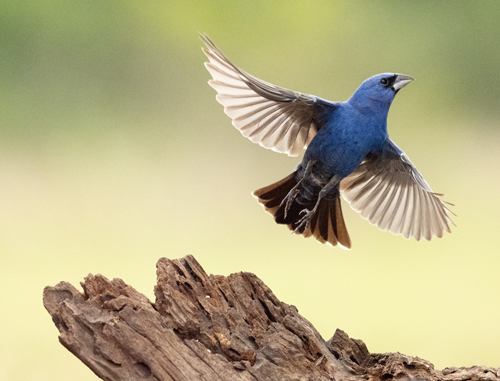
Blue Grosbeak
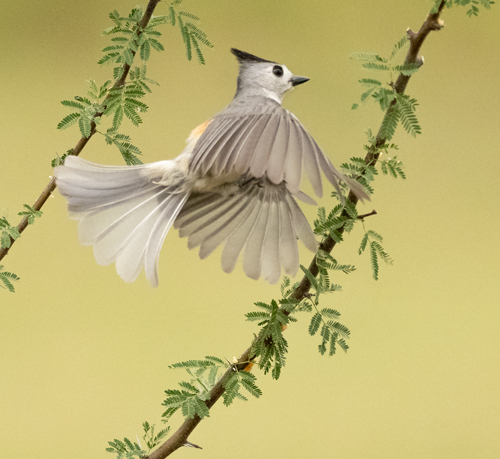
Black-crested Titmouse
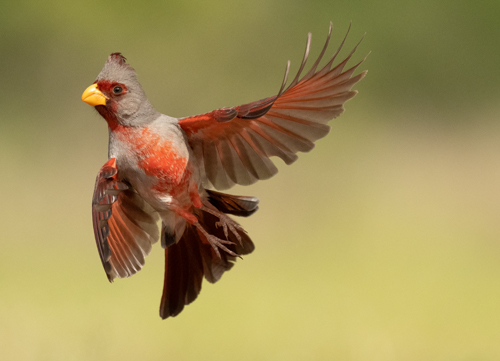
Pyrrhuloxia
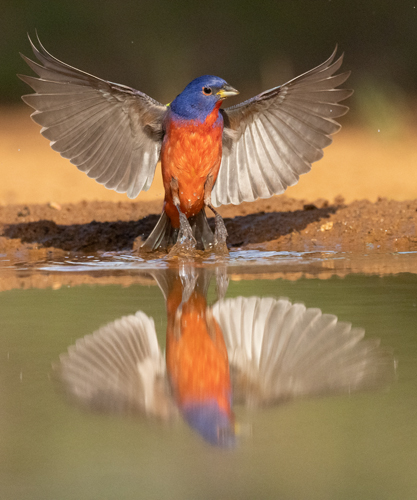
Painted Bunting
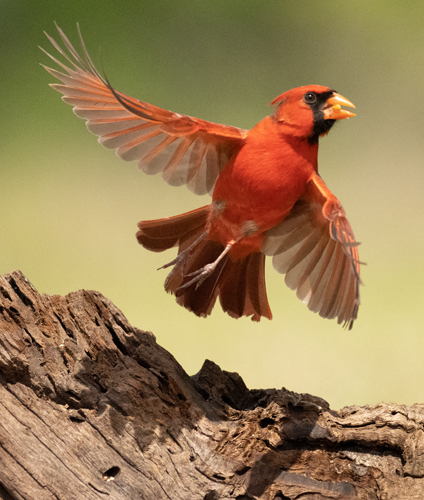
Northern Cardinal
We had fun with insects, too. I challenged a friend to capture this Dragonfly as it was about to land. Every time he fired, the Dragonfly was either perched or out-of-focus as it was still beyond the plane of focus. I was using ProCapture, and snapped as soon as the Dragonfly landed. The result, multiple images of the Dragonfly as it was about to land (it did this several times).
.jpg)
The most impressive demonstration of ProCapture, however, was with this flying Dragonfly. I only had one opportunity, as the Dragonflies were literally darting all around the pond, but once, one hovered long enough for me to acquire focus, and I fired. The image on the left is out-of-focus, as the camera's lag time, and my response, was too slow, and the insect had flown out-of-focus. However, with ProCapture, I had 35 prior frames, and I had 4 or 5 sharp images of the flying insect!
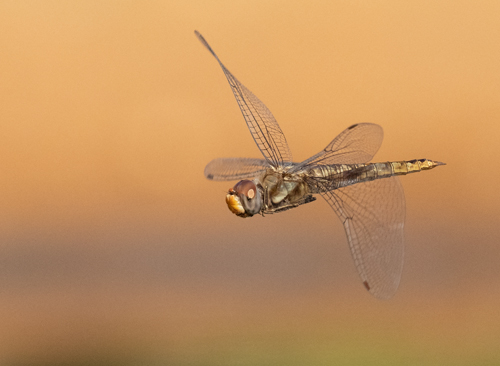
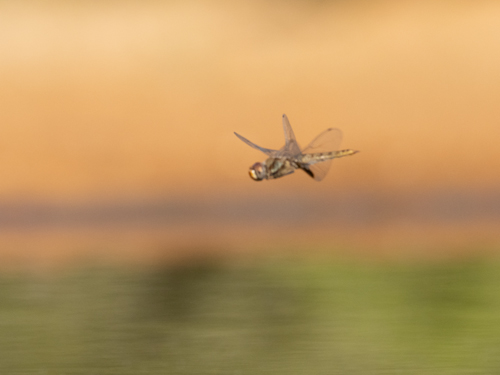
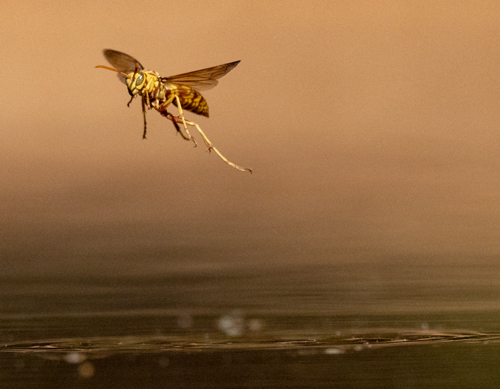
Hornets were floating on the pond, too, and would periodically launch in flight. Again, by the time anyone shot, the insect was out of the frame. However, with ProCapture, I caught the wasp on the water, and in the air, and when it remained in the plane of focus, I got several great shots.
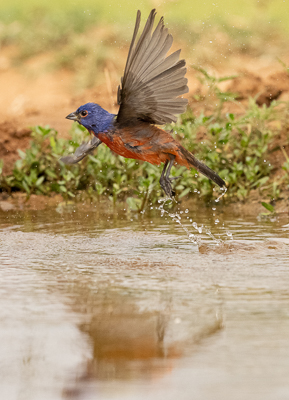
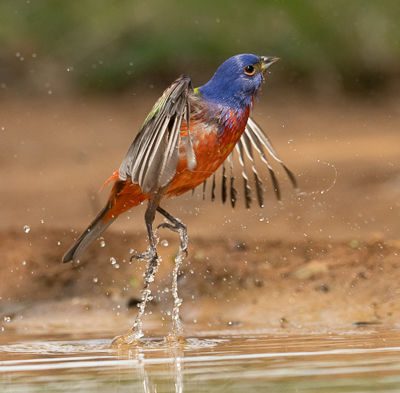
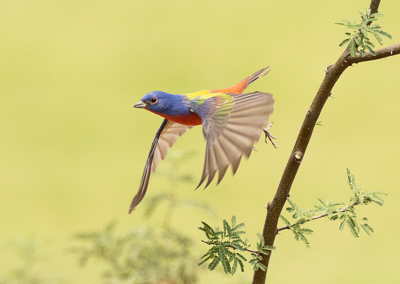
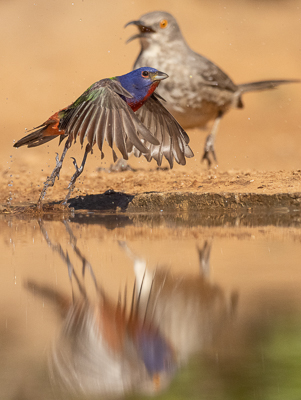
I can't say enough about ProCapture. The above Painted Buntings are just selects from several in a series for each of those images, meaning I'm picking a representative shot from a choice of many for each bird. I'd have been lucky to get one with my old gear, as one shooter on our trip proved, getting one shot -- flying away -- of a Painted Bunting! Here are more examples:
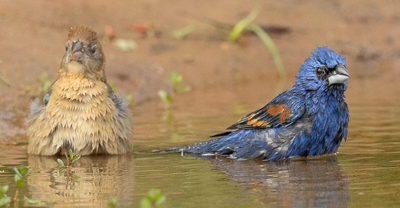
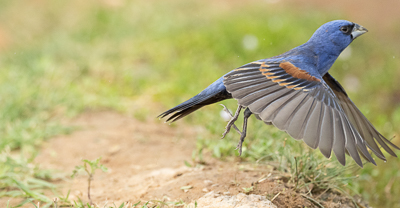
Blue Grosbeaks
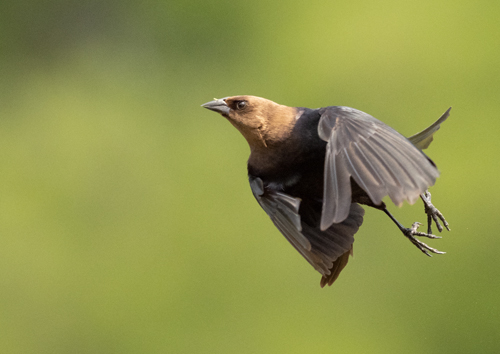
Who could imagine a Cowbird could make a beautiful shot?
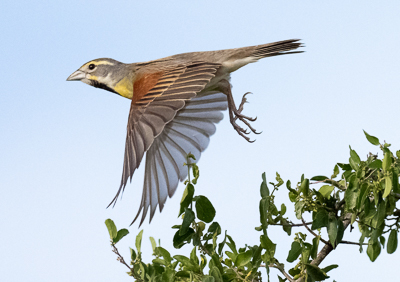
Dickissel
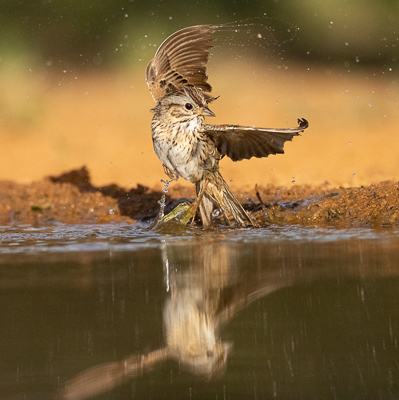
Lincoln Sparrow
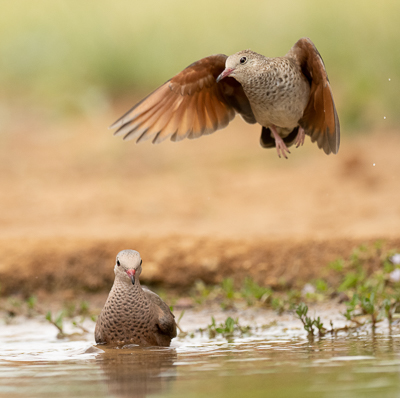
Ground Dove
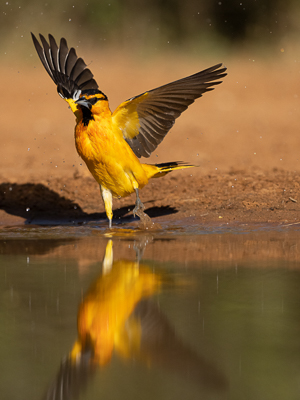
Bullock's Oriole
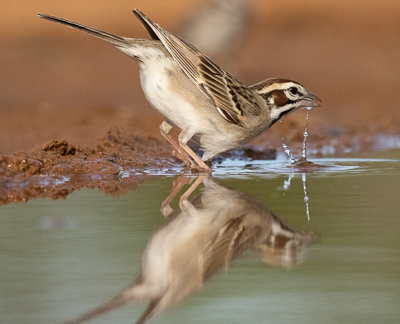
Lark Sparrow
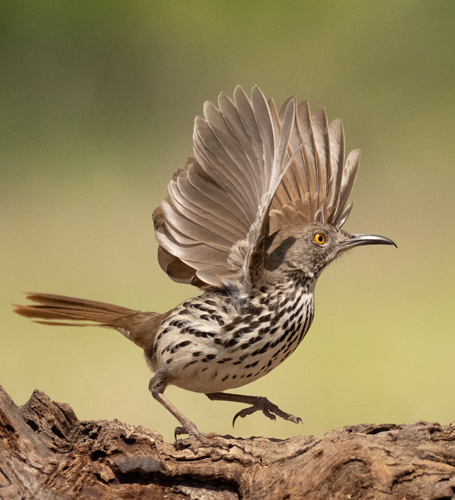
Long-billed Thrasher
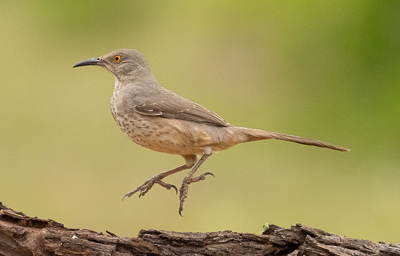
Curve-billed Thrasher - an ordinary pose suddenly turned magical, hopping along a log.
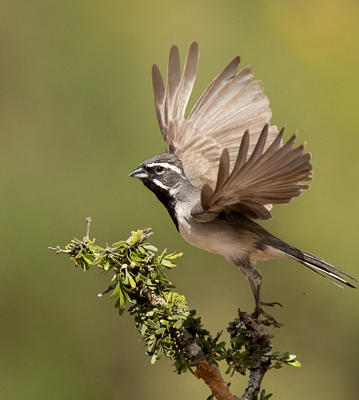
Black-throated Sparrow
Although we've been shooting Olympus for almost 9 months, our travels for Pumas, Tigers, Gorillas, etc., didn't involve taxing AF challenges. So I wasn't sure how well the cameras would perform for birds in flight. I discovered, as hoped, that the M1X did quite well. Here's some examples:
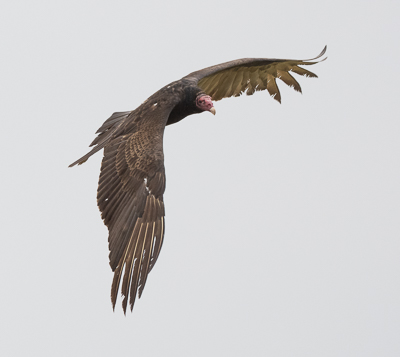
Turkey Vulture - not the fastest flier, but sharp.
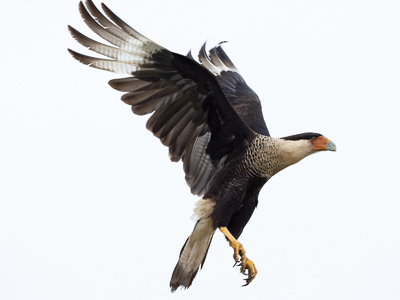
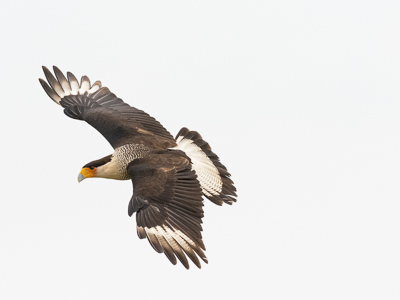
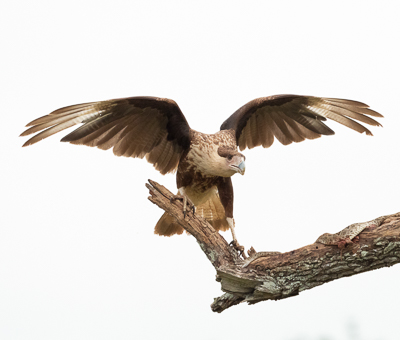
.jpg)
Focus held, despite a challenging background!
.jpg)
Crested Caracaras - these birds flew in much faster, and getting sharp shots of birds flying parallel was a no-brainer, but I was happy to see in-coming shots were mastered well, as well.
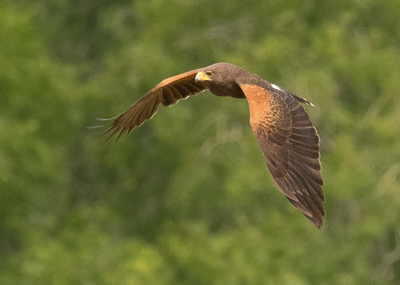
Harris Hawk - this is one of a series -- the bird was rather small in the frame and this is cropped, but the AF held focus throughout, despite a busy and potentially letal background. Subsequently, on other shoots I found AF worked equally well with busy backgrounds.
Shooting with my friends, we had a friendly contest to catch Kiskadee and Scissor-tailed Flycatchers around a pond. I wanted to catch a Scissor-tailed as it dipped into the water -- a nearly impossible task, considering the birds came out of nowhere and hit anywhere in the pond. Needless to say, I got shots no one else did -- and it wasn't my skill that was responsible!
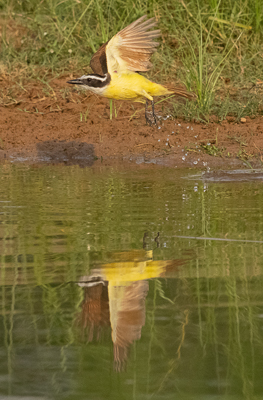
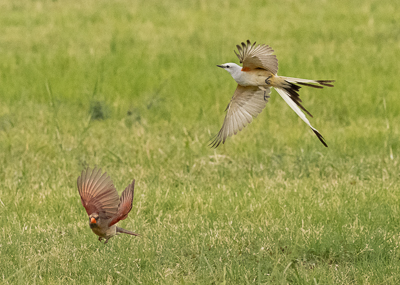
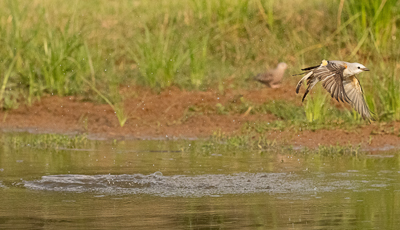
I guess it is because of the small sensor, but depth of field is definitely increased over my full-frame cameras. Don't ask me why ... I'm not clear on this. But here's a shot that really illustrates this. I was focused on the limb, using ProCapture, and when this rare Couch's Kingbird launched, it flew towards the camera. There is probably 8 inches between the bird's beak and the limb -- at f4, and everything is sharp! The image is cropped (so the bird was about 1/3 smaller in my full image), so DofF did increase, but still! And ... at 1/20,000th of a sec!
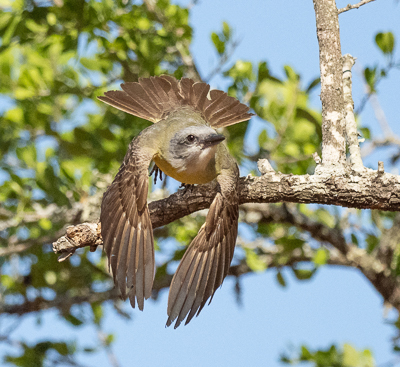
We did extremely well at both ranches, Santa Clara and Laguna Seca, and we're anxious to return -- in 2021. Next year, we're in Ecuador and the Galapagos at this time, but we'll be back. I'll conclude the Texas shoots with this highlight -- a Roadrunner that ran passed our blind repeatedly, with a lizard in its bill!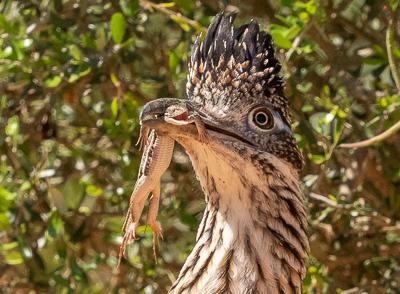
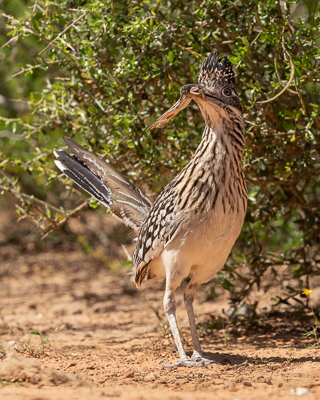
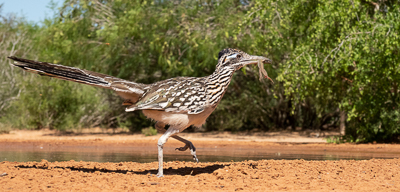
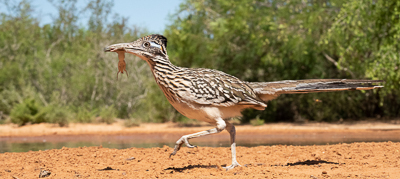
The bottom 2 shots were made with a 12-100mm lens, with the bird running by withing 4 feet of our blind!
Arizona Hummingbirds and Bats Photo Tour
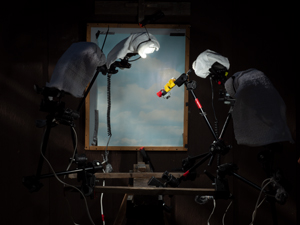 We've been doing this photo tour for around 30 years, missing just one or two seasons in all that time. The preparation for this shoot is incredible -- we have 5 hummingbird sets going, with 4 flashes each, and backups for all the flashes. Each set has 5 Manfrotto Articulating Arms, Stroboframe flash brackets, Wimberley Plamps, and multiple backgrounds. My half of this expedition takes up more than half of our 8 ft bed truck, with Mary's cooking supplies taking up the other half. It is a major packing, and major setup.
We've been doing this photo tour for around 30 years, missing just one or two seasons in all that time. The preparation for this shoot is incredible -- we have 5 hummingbird sets going, with 4 flashes each, and backups for all the flashes. Each set has 5 Manfrotto Articulating Arms, Stroboframe flash brackets, Wimberley Plamps, and multiple backgrounds. My half of this expedition takes up more than half of our 8 ft bed truck, with Mary's cooking supplies taking up the other half. It is a major packing, and major setup.
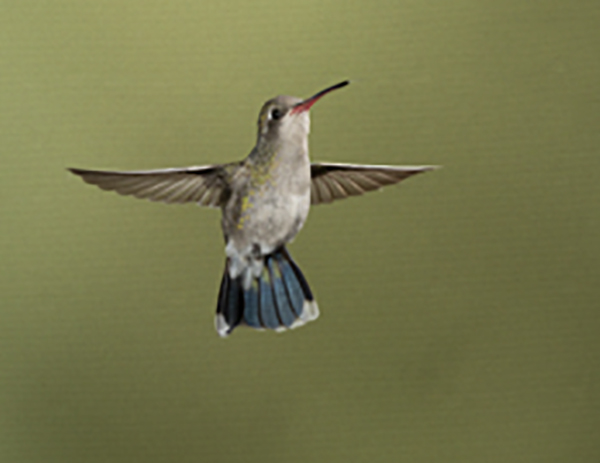 However, because of this, and the fact that we always arrived on-site several days before a shoot, our participants get great hummingbirds. Some photo groups arrive the day of the shoot, with a setup or two, and often have poor luck, as hummingbirds must find, and work into their 'trap line' schedule, the new feeders. I suspect, because we've set up at the same locations every year, our birds find our setups quickly, and start using them. We've been very successful.
However, because of this, and the fact that we always arrived on-site several days before a shoot, our participants get great hummingbirds. Some photo groups arrive the day of the shoot, with a setup or two, and often have poor luck, as hummingbirds must find, and work into their 'trap line' schedule, the new feeders. I suspect, because we've set up at the same locations every year, our birds find our setups quickly, and start using them. We've been very successful.
However, it might be time for a change, and I ponder this with some sadness as I know we've provided the best hummingbird shooting opportunities available. Our participants rotated through all 5 sets, so if one feeder wasn't too active, they wouldn't be wasting all of their time at an unproductive feeder. Additionally, we had natural light bait stations, incorporated a day visit to the Arizona Sonaran Desert Museum, and two days at 'The Pond,' for songbird, Roadrunner, and Bat photography. It was a very complete schedule.
Next year, because of our Galapagos and Ecuador Hummingbird Photo Tours, we'll be busy in April and May. And the following year, we have nothing scheduled, hoping to FINALLY be home during our own Spring, and to catch up and to photograph our own Pennsylvania springtime. Of course, that period will be flanked by a 5 week or so excursion to India, for Snow Leopards, Tigers, Black Panthers, Indian Rhinos, and more, and by Svalbard in late May, but still ... we'll see April and most of May at home. We're looking forward to that, and we're hoping that we'll have more time for this in the future.
So ... unless we visit Arizona in late summer, for nectar-feeding bats, lightning storms, and migrating Hummingbirds, this tour may mark our last in Arizona.
We began our tour with a scouting trip to Ron Niebrugge's Desert Photo Retreat, where my friends Tom and Deb photographed at his bird blinds while Mary and I set up at a waterhole for a camera trap setup. Ron had seen a Bobcat on his game camera, and I hoped I'd get lucky.
Ron's location is simply spectacular. Seemingly remote, it's just outside Tucson, and about 20 minutes from hotel lodging, but you'd think you were in the middle of the wilderness -- as you really are. The waterhole I was using is tiny, barely a yard square, and Ron had constructed a box to protect a camera from being tipped into the pond by Peccary (Javelina). I used a wide-angle zoom and 4 Phottix Flashes, attached via Ares I remotes, and fired by a Phottix Ares I trigger. I placed a Range IR to send a beam at the outer edge of the pond, in hopes that a fox, coyote, or bobcat would trip the beam and fire the camera. In contrast to the Barn Owl shooting, in this case I had to wire the Range IR to the camera, as lag time wouldn't be a problem and a continually clicking camera (as with bats and owls) might discourage an animal from approaching. If you're interested, contact Ron at
Desert Photo Retreat
https://desert-photo-retreat.com/
http://www.wildnatureimages.com
The following day we returned to collect the two cameras (another was set at a game trail, using a Sabre). I was encouraged to see that I still had battery life on both the cameras and flashes, and elated when I checked the cards. I had luck at both!
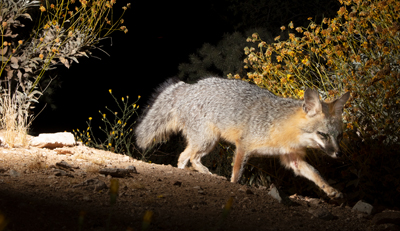
A Gray Fox shot using the Cognisys Sabre at the second waterhole.
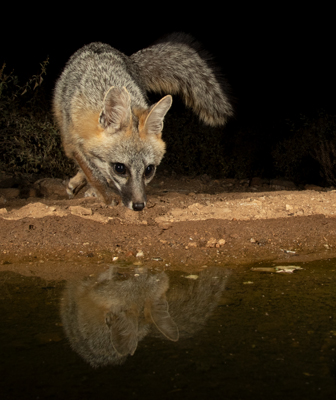
A Gray Fox at the yard-square waterhole.
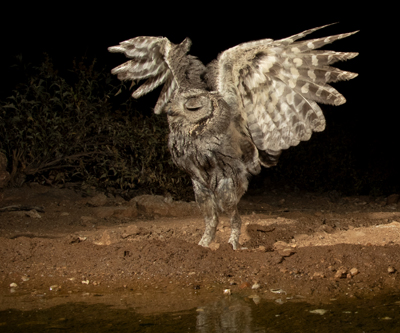
A Screech Owl landed several times, each time closing its eyes as it landed.

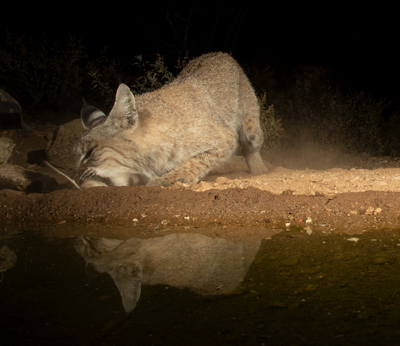
Success! A Bobcat triggered my RangeIR for a couple of poses, including one where the Bobcat captured a rodent that was, apparently, heading for a drink!
Ron's facility has a trailer for two photographers to stay overnight. We had friends we wanted to visit, and four people, so we couldn't do so, but we'd highly recommend photographers doing so, as the star photography would be spectacular, and the landscapes, at dawn and dusk, simply incredible.
We had another first -- another friend, Steve, informed us that a Northern Pigmy Owl was nesting in a tree only two hundred yards from our lodge. I visited it, met another old friend while there, and had my first opportunity to photograph a Pigmy Owl.
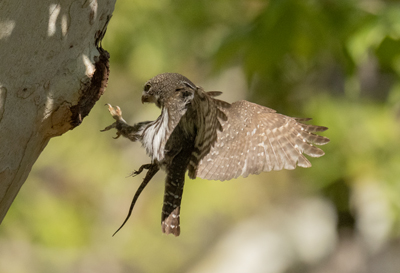
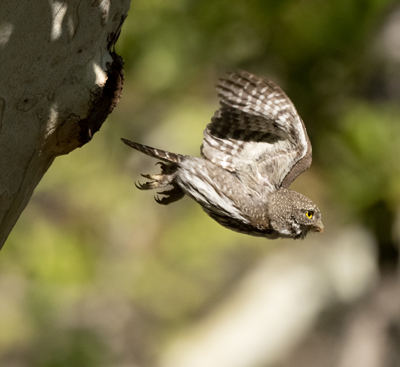
I wouldn't have got either of these shots without the Olympus M1X ProCapture feature. The owl practically rocketed into the nest hole, pausing only for a moment before disappearing inside. I had activated ProCapture and waited, as we'd heard the owl calling and we suspected it would fly in, and as it landed, I fired. The bird was inside the nest hole before human and camera lag time fired the camera, but with ProCapture, I also recorded the previous 35 frames, including the one, above, as the bird carried a lizard into the hole. A few minutes later, the owl exploded out of the nest hole, and again, ProCapture, caught the bird.

Over the years we've had a few chances to photograph the beautiful Elegant Trogan, but those chances always involved long hikes up the canyon into the high country. This year, a bachelor Trogan, intent on finding a mate, constantly patrolled the streambed right outside our cabins! Several participants got great shots just sitting by our first Hummingbird station. I used (guess!) ProCapture to catch the Trogan in flight, catching unique images in the best photographic opportunity I've ever had for this bird.
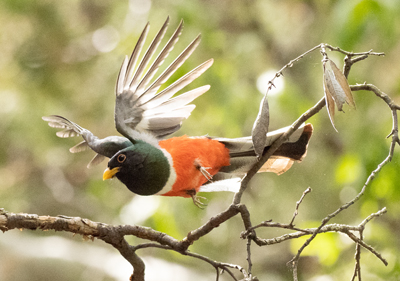
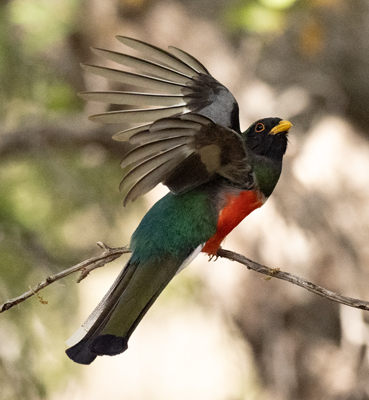
At our Number 4 Hummingbird set another Arizona bird trophy, a Painted Redstart, hunted the trees and underbrush close by.
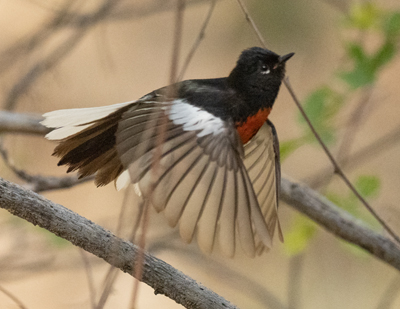
At our Number 5 hummingbird set, a pair of Summer Tanagers frequently visited. I later discovered that a mirror, stored in a alley-way of a storage building, attracted the male Tanager, who visited the mirror often, pecking at his rival. The female was always nearby ... perhaps waiting to choose the victor.
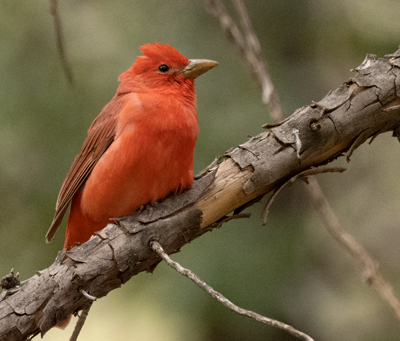
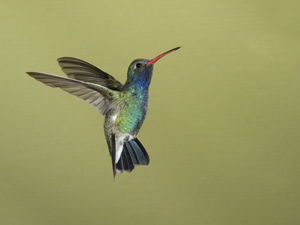
Although our Hummingbird setups were very active, Mary and I did virtually no personal shooting -- we do have 30 years' worth of images. Our only shots consisted of test shots for checking the lighting ... but our previous Trip Reports illustrate plenty of hummingbirds, if you're interested.
However, we did shoot at our other location - The Pond at Elephant Head. Now under a new owner, Dano Grayson, the Pond offered plenty of shooting opportunities, including songbirds, Roadrunners, small rodents, and rabbits and jack rabbits. We scheduled two days for each of our groups, although unseasonable, and completely unique - odd - unprecedented - weather prevented us from visiting one day as it rained hard most of the day. Nonetheless, we got great shots of multiple species. Here's Dano's contact:
The Pond at Elephant Head
www.danograyson.com/the-pond-at-elephant-head
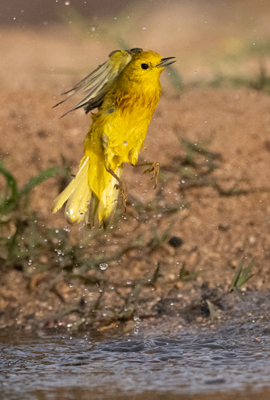
Yellow Warbler
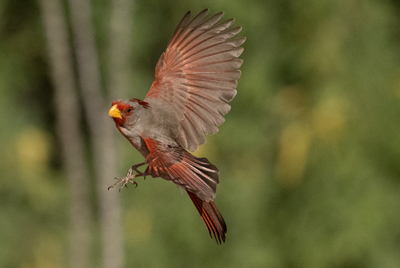
Pyrrhuloxia
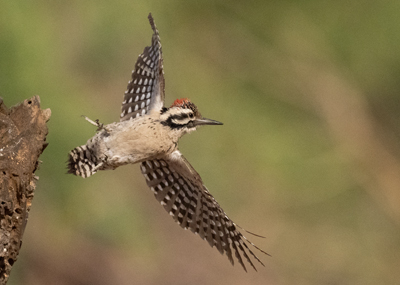
Ladder-backed Woodpecker
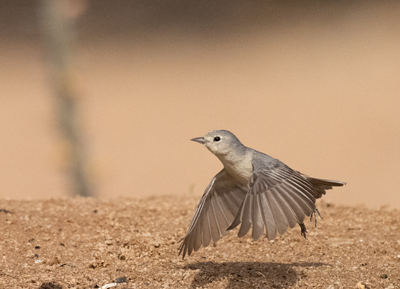
Lucy Warbler
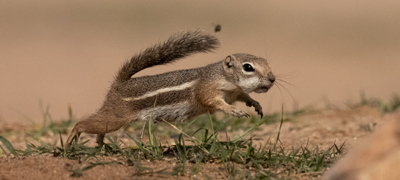
Harrisson Antelope Ground Squirrel
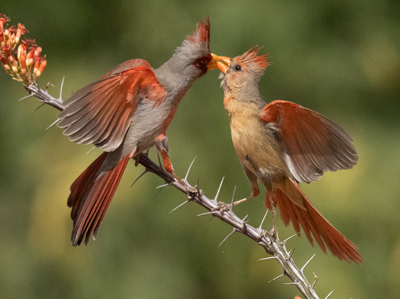
Pyrrhuloxia and Cardinal in a spat - not a kiss!
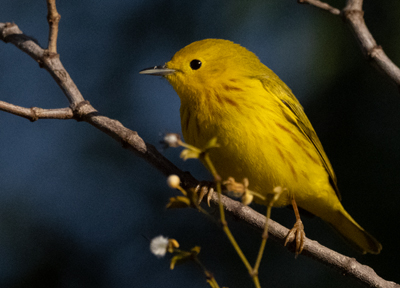
Yellow Warbler
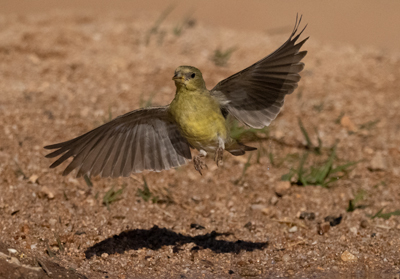
Lesser Goldfinch
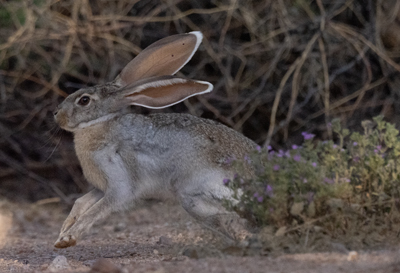
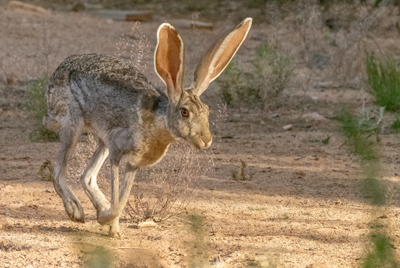
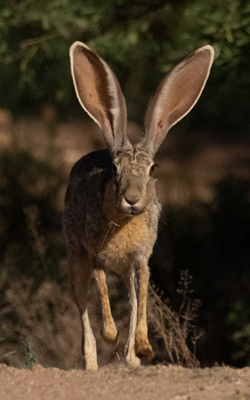
Antelope Jackrabbit
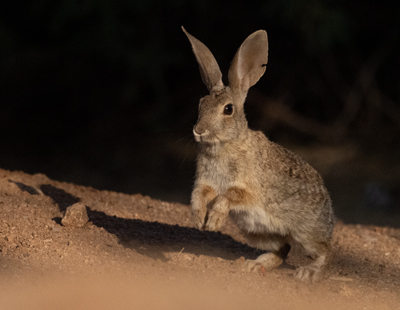
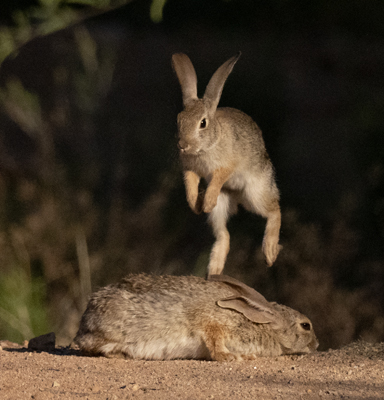
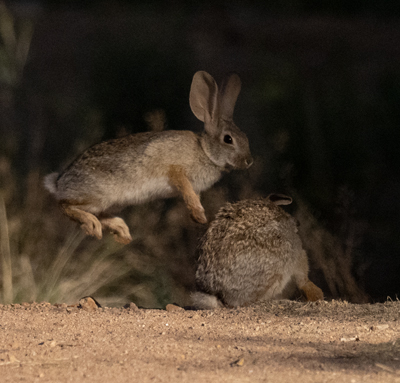
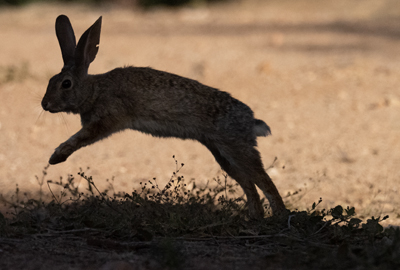
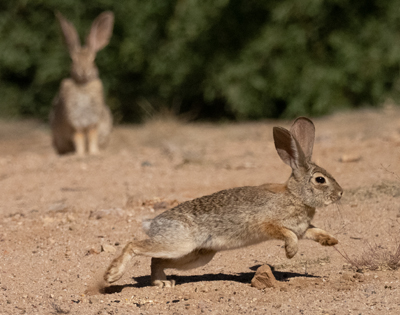
Desert Cottontail
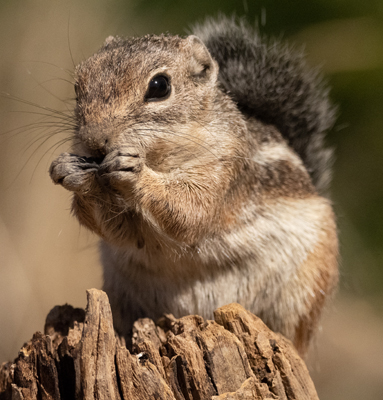
Harrison Antelope Ground Squirrel
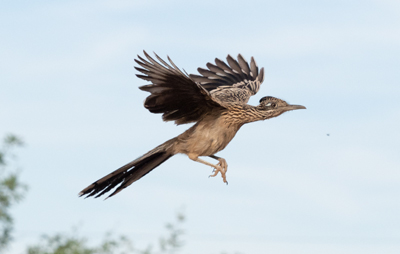
Roadrunner - trained to fly from perch to perch
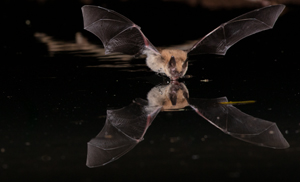 One of the other highlights at The Pond was the Bat photography. Dano has a reliable setup, and for the first time in a long while I didn't use my flashes, but instead used Dano's - and everything worked fine.
One of the other highlights at The Pond was the Bat photography. Dano has a reliable setup, and for the first time in a long while I didn't use my flashes, but instead used Dano's - and everything worked fine.
The procedure for this shoot is similar to what I did for the Barn Owls - a long shutter speed, insuring the shutter is open when the flashes fire - tripped by an infrared beam. Cameras fire continuously, via a locked 'on' electronic cable, for a 20 second exposure, followed immediately by another 20 second exposure, and so 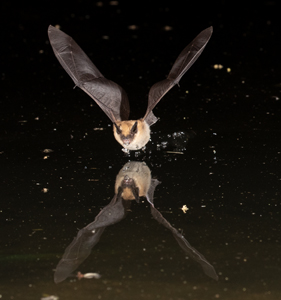 on, with the camera set on continuous, instead of single shot. Sound's simple, right?
on, with the camera set on continuous, instead of single shot. Sound's simple, right?
Well, despite the fact that we review this, and stress and stress and stress that participants practice this before the shoot, to insure they get it right, about half the shooters failed on their first shoot. Most got everything sorted out for their second attempt, but a few still failed. In some cases, low noise reduction was turned on - WRONG, or using an intervalometer - WRONG, or not setting their lens on manual focus. Dano did as good a job as he could trying to trouble shoot in real time what was wrong, but with camera menus, that was fruitless.
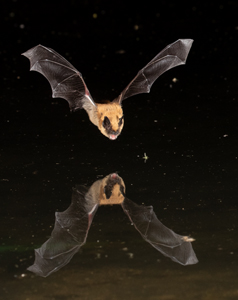
I can't stress enough how important it is to go through a dry run, in a room, doing EVERYTHING that one would do for a real shoot.Those that failed generally did not. Fortunately, we had two nights each time, so photographers had another chance and most were successful.
We also scheduled a trip to the Arizona Sonoran Desert Museum in Tucson, and our first group had a great time there. Unfortunately, the unseasonal rain that wiped out a day on the second trip made a trip there impractical -- afterall, the shoot was for wild hummingbirds. Accordingly, we passed on another visit, giving everyone the maximum amount of time at our hummingbird shoots.
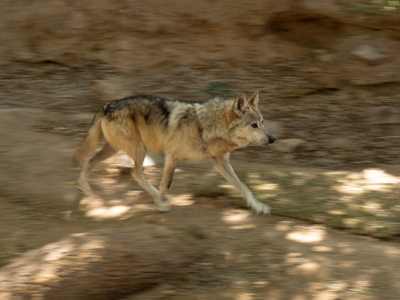
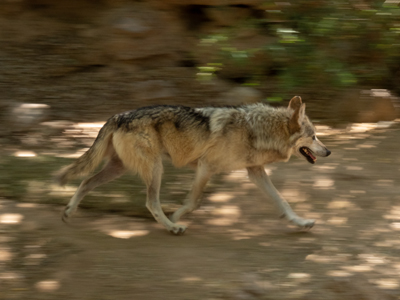
Mexican Gray Wolf - slow shutter speed, panned, at 1/40th sec,
12-100mm lens
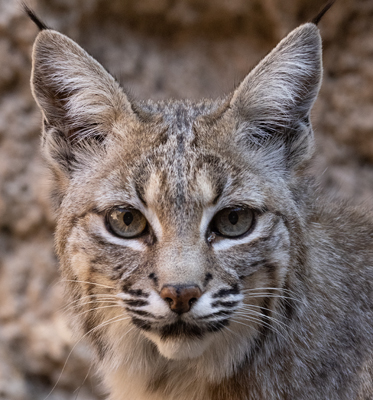
I've provided a lot of detail here on how we've done these trips, with the hope that anyone following us in doing shoots here has data to make this wonderful area a most successful shoot. Perhaps we'll return ... it was a big part of our life and we love southern Arizona, and have made so many friends here, but for now we're looking forward to Ecuador and the Galapagos, and home, too, during this season. It's been a great run!
Why you should travel with us
Testimonials
Check out the prices -
Olympus Official Store
Why you should travel with us
Testimonials
Featured on ShotKit - read the interview
Join us on Facebook at: Follow Hoot Hollow
Office Phone: (717) 543-6423
Or FAX us at: (717) 543-5342
Mary and Joe are proud to endorse the Photo Retailer that has
done the absolute most in supporting nature photography in all
its facets ---

Check out the Monthly Specials
from Hunt's

Golden-fronted Woodpecker,
South Texas Photo Tour

Bobcat at waterhole,
Ron Niebrugge's photo site

Elegant Trogan,
Santa Rita Mts - Arizona Hummingbirds and Bats Photo tour

The Bat Shoot - AZ
Two Photo Tours and several Scouting Trips occupied our time in late April and early May, which included extremely productive shoots in southern Texas and in southern Arizona, where, sadly, we may have concluded our Arizona Hummingbird Photo Shoots. We've been doing Arizona's hummingbirds for thirty years, and in doing so, we've missed our Spring season here in Pennsylvania every year. Next year we'll miss it again, with our trips to Ecuador for hummingbirds, and the fantastic Galapagos Islands for its wildlife. The following year, if all goes as planned, we'll be home in Spring, to enjoy the changing of seasons for the first time in three decades!
Since pictures tell a thousand words, I'll be brief in the text, and instead I thought it might be more helpful to discuss some of the images that illustrate the report. So, here's the Reports:
 Texas Bird and Wildlife Photo Tour
Texas Bird and Wildlife Photo Tour
We visited two photo ranches, Laguna Seca and Santa Clara, for this tour. Although we've always included Santa Clara on our tours, this was the first time we visited Laguna Seca. We're extremely glad we did, as the landscape and wildlife there were different enough to make the two ranches distinct and well worth visiting.
We were extremely fortunate to have the owner of Laguna Seca join us for the shoot. His help in arranging props, and in predicting where a bird might land, was invaluable, and our time shooting with him was extremely enjoyable, too. Birds were are primary focus at Laguan Seca, and we did well with a wide assortment of south Texas species.
I also had a chance to set up for a Barn Owl nest, and that was a real adventure. I was planning to use a Range IR attached to my camera, intending to have the owl trip the beam and fire the camera. When a camera is attached to a beam, however, there is a lag time, and I'd have to guess how far an owl might travel after breaking the infrared beam before my camera actually fired. So .... while I was in one of the photo blinds I decided I'd be better off tripping a flash, with the camera shutter open as we do for our bat photography. After we were finished in the bird blinds I started setting up, discovering that in making my initial decision, I stupidly left the flash cable necessary for the alternative technique. Dusk was falling, and my flash cable was back at the hotel, about 25 minutes away. I decided to get it, and drove faster than I'd like to make the round trip in time for the owls. I made it, and the owls had not yet left the nest box for their night's hunting.



Here's what was involved in this shot: 4 Phottix Flashes with 1 Phottix Ares II
transmitter to fire the flashes; 4 8-foot tall Light Stands; 1 Really Right Stuff Groundpod for my Range IR infrared transmitter; 1 Really Right Stuff tripod and FH350 videohead for the camera; camera.
When a RangeIR is wired to the flashes there is no lag time, but the shutter must be open to record any flash triggered when an owl breaks the beam. I set the camera shutter for 30 seconds, assuming that an owl flying in to the nest box to feed its chicks would remain there longer than 30 seconds. This worked, although I did have one frame where the owl flew in with a rat and flew back out, creating a double image.

I had hoped to have more than one chance to film the owls but a horrific storm was brewing on the second night. Nonetheless, I felt pretty good about getting everything setup and going, despite losing more than one hour for a drive for a cable!
 I had a chance at another nest, but unfortunately the Barn Owls had fledged. They were still using their nest box, but the adults were no longer feeding their babies inside the box. Instead, if they were feeding them at all, they did so on perches spread out across the scrub. For this setup I knew I wouldn't get birds flying in with food, and I hoped to get some shots as the birds left the nest box for their evening hunt or begging routine. Accordingly, I set up for a side view, but when I arrived to turn on the gear, all of the owls were out, flying about and enjoying the dusk. I hoped a bird might return, and set up in the same fashion I did previously. One bird flew in ... one shot.
I had a chance at another nest, but unfortunately the Barn Owls had fledged. They were still using their nest box, but the adults were no longer feeding their babies inside the box. Instead, if they were feeding them at all, they did so on perches spread out across the scrub. For this setup I knew I wouldn't get birds flying in with food, and I hoped to get some shots as the birds left the nest box for their evening hunt or begging routine. Accordingly, I set up for a side view, but when I arrived to turn on the gear, all of the owls were out, flying about and enjoying the dusk. I hoped a bird might return, and set up in the same fashion I did previously. One bird flew in ... one shot.
Since Mary and I have switched to Olympus we really hadn't had a great chance to use ProCapture, the absolute game-changer for action photography. Our shoots at both ranches changed that, and we had multiple opportunities to catch birds in flight, revealing poses we'd have missed with traditional gear. ProCapture, with the flagship M1X camera, records 35 frames prior to the frame where the camera actually fires, doing so in a loop that continually rewrites over the 35th frame as the newest frame is recorded. Images are not written to the SD card until you actually fire off a shot, so you're not eating up SD card memory. The result, instead of having the tail-end of a bird or nothing at all in the frame, we were recording the entire take-off, picking the shot that best illustrated the behavior.

Green Jay

Blue Grosbeak

Black-crested Titmouse

Pyrrhuloxia

Painted Bunting

Northern Cardinal
We had fun with insects, too. I challenged a friend to capture this Dragonfly as it was about to land. Every time he fired, the Dragonfly was either perched or out-of-focus as it was still beyond the plane of focus. I was using ProCapture, and snapped as soon as the Dragonfly landed. The result, multiple images of the Dragonfly as it was about to land (it did this several times).
.jpg)
The most impressive demonstration of ProCapture, however, was with this flying Dragonfly. I only had one opportunity, as the Dragonflies were literally darting all around the pond, but once, one hovered long enough for me to acquire focus, and I fired. The image on the left is out-of-focus, as the camera's lag time, and my response, was too slow, and the insect had flown out-of-focus. However, with ProCapture, I had 35 prior frames, and I had 4 or 5 sharp images of the flying insect!



Hornets were floating on the pond, too, and would periodically launch in flight. Again, by the time anyone shot, the insect was out of the frame. However, with ProCapture, I caught the wasp on the water, and in the air, and when it remained in the plane of focus, I got several great shots.




I can't say enough about ProCapture. The above Painted Buntings are just selects from several in a series for each of those images, meaning I'm picking a representative shot from a choice of many for each bird. I'd have been lucky to get one with my old gear, as one shooter on our trip proved, getting one shot -- flying away -- of a Painted Bunting! Here are more examples:


Blue Grosbeaks

Who could imagine a Cowbird could make a beautiful shot?

Dickissel

Lincoln Sparrow

Ground Dove

Bullock's Oriole

Lark Sparrow

Long-billed Thrasher

Curve-billed Thrasher - an ordinary pose suddenly turned magical, hopping along a log.

Black-throated Sparrow
Although we've been shooting Olympus for almost 9 months, our travels for Pumas, Tigers, Gorillas, etc., didn't involve taxing AF challenges. So I wasn't sure how well the cameras would perform for birds in flight. I discovered, as hoped, that the M1X did quite well. Here's some examples:

Turkey Vulture - not the fastest flier, but sharp.



.jpg)
Focus held, despite a challenging background!
.jpg)
Crested Caracaras - these birds flew in much faster, and getting sharp shots of birds flying parallel was a no-brainer, but I was happy to see in-coming shots were mastered well, as well.

Harris Hawk - this is one of a series -- the bird was rather small in the frame and this is cropped, but the AF held focus throughout, despite a busy and potentially letal background. Subsequently, on other shoots I found AF worked equally well with busy backgrounds.
Shooting with my friends, we had a friendly contest to catch Kiskadee and Scissor-tailed Flycatchers around a pond. I wanted to catch a Scissor-tailed as it dipped into the water -- a nearly impossible task, considering the birds came out of nowhere and hit anywhere in the pond. Needless to say, I got shots no one else did -- and it wasn't my skill that was responsible!



I guess it is because of the small sensor, but depth of field is definitely increased over my full-frame cameras. Don't ask me why ... I'm not clear on this. But here's a shot that really illustrates this. I was focused on the limb, using ProCapture, and when this rare Couch's Kingbird launched, it flew towards the camera. There is probably 8 inches between the bird's beak and the limb -- at f4, and everything is sharp! The image is cropped (so the bird was about 1/3 smaller in my full image), so DofF did increase, but still! And ... at 1/20,000th of a sec!

We did extremely well at both ranches, Santa Clara and Laguna Seca, and we're anxious to return -- in 2021. Next year, we're in Ecuador and the Galapagos at this time, but we'll be back. I'll conclude the Texas shoots with this highlight -- a Roadrunner that ran passed our blind repeatedly, with a lizard in its bill!



The bottom 2 shots were made with a 12-100mm lens, with the bird running by withing 4 feet of our blind!
Arizona Hummingbirds and Bats Photo Tour
 We've been doing this photo tour for around 30 years, missing just one or two seasons in all that time. The preparation for this shoot is incredible -- we have 5 hummingbird sets going, with 4 flashes each, and backups for all the flashes. Each set has 5 Manfrotto Articulating Arms, Stroboframe flash brackets, Wimberley Plamps, and multiple backgrounds. My half of this expedition takes up more than half of our 8 ft bed truck, with Mary's cooking supplies taking up the other half. It is a major packing, and major setup.
We've been doing this photo tour for around 30 years, missing just one or two seasons in all that time. The preparation for this shoot is incredible -- we have 5 hummingbird sets going, with 4 flashes each, and backups for all the flashes. Each set has 5 Manfrotto Articulating Arms, Stroboframe flash brackets, Wimberley Plamps, and multiple backgrounds. My half of this expedition takes up more than half of our 8 ft bed truck, with Mary's cooking supplies taking up the other half. It is a major packing, and major setup.
 However, because of this, and the fact that we always arrived on-site several days before a shoot, our participants get great hummingbirds. Some photo groups arrive the day of the shoot, with a setup or two, and often have poor luck, as hummingbirds must find, and work into their 'trap line' schedule, the new feeders. I suspect, because we've set up at the same locations every year, our birds find our setups quickly, and start using them. We've been very successful.
However, because of this, and the fact that we always arrived on-site several days before a shoot, our participants get great hummingbirds. Some photo groups arrive the day of the shoot, with a setup or two, and often have poor luck, as hummingbirds must find, and work into their 'trap line' schedule, the new feeders. I suspect, because we've set up at the same locations every year, our birds find our setups quickly, and start using them. We've been very successful.
However, it might be time for a change, and I ponder this with some sadness as I know we've provided the best hummingbird shooting opportunities available. Our participants rotated through all 5 sets, so if one feeder wasn't too active, they wouldn't be wasting all of their time at an unproductive feeder. Additionally, we had natural light bait stations, incorporated a day visit to the Arizona Sonaran Desert Museum, and two days at 'The Pond,' for songbird, Roadrunner, and Bat photography. It was a very complete schedule.
Next year, because of our Galapagos and Ecuador Hummingbird Photo Tours, we'll be busy in April and May. And the following year, we have nothing scheduled, hoping to FINALLY be home during our own Spring, and to catch up and to photograph our own Pennsylvania springtime. Of course, that period will be flanked by a 5 week or so excursion to India, for Snow Leopards, Tigers, Black Panthers, Indian Rhinos, and more, and by Svalbard in late May, but still ... we'll see April and most of May at home. We're looking forward to that, and we're hoping that we'll have more time for this in the future.
So ... unless we visit Arizona in late summer, for nectar-feeding bats, lightning storms, and migrating Hummingbirds, this tour may mark our last in Arizona.
We began our tour with a scouting trip to Ron Niebrugge's Desert Photo Retreat, where my friends Tom and Deb photographed at his bird blinds while Mary and I set up at a waterhole for a camera trap setup. Ron had seen a Bobcat on his game camera, and I hoped I'd get lucky.
Ron's location is simply spectacular. Seemingly remote, it's just outside Tucson, and about 20 minutes from hotel lodging, but you'd think you were in the middle of the wilderness -- as you really are. The waterhole I was using is tiny, barely a yard square, and Ron had constructed a box to protect a camera from being tipped into the pond by Peccary (Javelina). I used a wide-angle zoom and 4 Phottix Flashes, attached via Ares I remotes, and fired by a Phottix Ares I trigger. I placed a Range IR to send a beam at the outer edge of the pond, in hopes that a fox, coyote, or bobcat would trip the beam and fire the camera. In contrast to the Barn Owl shooting, in this case I had to wire the Range IR to the camera, as lag time wouldn't be a problem and a continually clicking camera (as with bats and owls) might discourage an animal from approaching. If you're interested, contact Ron at
Desert Photo Retreat
https://desert-photo-retreat.com/
http://www.wildnatureimages.com
The following day we returned to collect the two cameras (another was set at a game trail, using a Sabre). I was encouraged to see that I still had battery life on both the cameras and flashes, and elated when I checked the cards. I had luck at both!

A Gray Fox shot using the Cognisys Sabre at the second waterhole.

A Gray Fox at the yard-square waterhole.

A Screech Owl landed several times, each time closing its eyes as it landed.


Success! A Bobcat triggered my RangeIR for a couple of poses, including one where the Bobcat captured a rodent that was, apparently, heading for a drink!
Ron's facility has a trailer for two photographers to stay overnight. We had friends we wanted to visit, and four people, so we couldn't do so, but we'd highly recommend photographers doing so, as the star photography would be spectacular, and the landscapes, at dawn and dusk, simply incredible.
We had another first -- another friend, Steve, informed us that a Northern Pigmy Owl was nesting in a tree only two hundred yards from our lodge. I visited it, met another old friend while there, and had my first opportunity to photograph a Pigmy Owl.


I wouldn't have got either of these shots without the Olympus M1X ProCapture feature. The owl practically rocketed into the nest hole, pausing only for a moment before disappearing inside. I had activated ProCapture and waited, as we'd heard the owl calling and we suspected it would fly in, and as it landed, I fired. The bird was inside the nest hole before human and camera lag time fired the camera, but with ProCapture, I also recorded the previous 35 frames, including the one, above, as the bird carried a lizard into the hole. A few minutes later, the owl exploded out of the nest hole, and again, ProCapture, caught the bird.

Over the years we've had a few chances to photograph the beautiful Elegant Trogan, but those chances always involved long hikes up the canyon into the high country. This year, a bachelor Trogan, intent on finding a mate, constantly patrolled the streambed right outside our cabins! Several participants got great shots just sitting by our first Hummingbird station. I used (guess!) ProCapture to catch the Trogan in flight, catching unique images in the best photographic opportunity I've ever had for this bird.


At our Number 4 Hummingbird set another Arizona bird trophy, a Painted Redstart, hunted the trees and underbrush close by.

At our Number 5 hummingbird set, a pair of Summer Tanagers frequently visited. I later discovered that a mirror, stored in a alley-way of a storage building, attracted the male Tanager, who visited the mirror often, pecking at his rival. The female was always nearby ... perhaps waiting to choose the victor.


Although our Hummingbird setups were very active, Mary and I did virtually no personal shooting -- we do have 30 years' worth of images. Our only shots consisted of test shots for checking the lighting ... but our previous Trip Reports illustrate plenty of hummingbirds, if you're interested.
However, we did shoot at our other location - The Pond at Elephant Head. Now under a new owner, Dano Grayson, the Pond offered plenty of shooting opportunities, including songbirds, Roadrunners, small rodents, and rabbits and jack rabbits. We scheduled two days for each of our groups, although unseasonable, and completely unique - odd - unprecedented - weather prevented us from visiting one day as it rained hard most of the day. Nonetheless, we got great shots of multiple species. Here's Dano's contact:
The Pond at Elephant Head
www.danograyson.com/the-pond-at-elephant-head

Yellow Warbler

Pyrrhuloxia

Ladder-backed Woodpecker

Lucy Warbler

Harrisson Antelope Ground Squirrel

Pyrrhuloxia and Cardinal in a spat - not a kiss!

Yellow Warbler

Lesser Goldfinch



Antelope Jackrabbit





Desert Cottontail

Harrison Antelope Ground Squirrel

Roadrunner - trained to fly from perch to perch
 One of the other highlights at The Pond was the Bat photography. Dano has a reliable setup, and for the first time in a long while I didn't use my flashes, but instead used Dano's - and everything worked fine.
One of the other highlights at The Pond was the Bat photography. Dano has a reliable setup, and for the first time in a long while I didn't use my flashes, but instead used Dano's - and everything worked fine.
The procedure for this shoot is similar to what I did for the Barn Owls - a long shutter speed, insuring the shutter is open when the flashes fire - tripped by an infrared beam. Cameras fire continuously, via a locked 'on' electronic cable, for a 20 second exposure, followed immediately by another 20 second exposure, and so  on, with the camera set on continuous, instead of single shot. Sound's simple, right?
on, with the camera set on continuous, instead of single shot. Sound's simple, right?
Well, despite the fact that we review this, and stress and stress and stress that participants practice this before the shoot, to insure they get it right, about half the shooters failed on their first shoot. Most got everything sorted out for their second attempt, but a few still failed. In some cases, low noise reduction was turned on - WRONG, or using an intervalometer - WRONG, or not setting their lens on manual focus. Dano did as good a job as he could trying to trouble shoot in real time what was wrong, but with camera menus, that was fruitless.

I can't stress enough how important it is to go through a dry run, in a room, doing EVERYTHING that one would do for a real shoot.Those that failed generally did not. Fortunately, we had two nights each time, so photographers had another chance and most were successful.
We also scheduled a trip to the Arizona Sonoran Desert Museum in Tucson, and our first group had a great time there. Unfortunately, the unseasonal rain that wiped out a day on the second trip made a trip there impractical -- afterall, the shoot was for wild hummingbirds. Accordingly, we passed on another visit, giving everyone the maximum amount of time at our hummingbird shoots.


Mexican Gray Wolf - slow shutter speed, panned, at 1/40th sec,
12-100mm lens

I've provided a lot of detail here on how we've done these trips, with the hope that anyone following us in doing shoots here has data to make this wonderful area a most successful shoot. Perhaps we'll return ... it was a big part of our life and we love southern Arizona, and have made so many friends here, but for now we're looking forward to Ecuador and the Galapagos, and home, too, during this season. It's been a great run!
Why you should travel with us
Testimonials
Check out the prices -
Olympus Official Store
Why you should travel with us
Testimonials
Featured on ShotKit - read the interview
Join us on Facebook at: Follow Hoot Hollow
Office Phone: (717) 543-6423
Or FAX us at: (717) 543-5342
Mary and Joe are proud to endorse the Photo Retailer that has
done the absolute most in supporting nature photography in all
its facets ---

Check out the Monthly Specials
from Hunt's

Golden-fronted Woodpecker,
South Texas Photo Tour

Bobcat at waterhole,
Ron Niebrugge's photo site

Elegant Trogan,
Santa Rita Mts - Arizona Hummingbirds and Bats Photo tour

The Bat Shoot - AZ
Two Photo Tours and several Scouting Trips occupied our time in late April and early May, which included extremely productive shoots in southern Texas and in southern Arizona, where, sadly, we may have concluded our Arizona Hummingbird Photo Shoots. We've been doing Arizona's hummingbirds for thirty years, and in doing so, we've missed our Spring season here in Pennsylvania every year. Next year we'll miss it again, with our trips to Ecuador for hummingbirds, and the fantastic Galapagos Islands for its wildlife. The following year, if all goes as planned, we'll be home in Spring, to enjoy the changing of seasons for the first time in three decades!
Since pictures tell a thousand words, I'll be brief in the text, and instead I thought it might be more helpful to discuss some of the images that illustrate the report. So, here's the Reports:
 Texas Bird and Wildlife Photo Tour
Texas Bird and Wildlife Photo Tour
We visited two photo ranches, Laguna Seca and Santa Clara, for this tour. Although we've always included Santa Clara on our tours, this was the first time we visited Laguna Seca. We're extremely glad we did, as the landscape and wildlife there were different enough to make the two ranches distinct and well worth visiting.
We were extremely fortunate to have the owner of Laguna Seca join us for the shoot. His help in arranging props, and in predicting where a bird might land, was invaluable, and our time shooting with him was extremely enjoyable, too. Birds were are primary focus at Laguan Seca, and we did well with a wide assortment of south Texas species.
I also had a chance to set up for a Barn Owl nest, and that was a real adventure. I was planning to use a Range IR attached to my camera, intending to have the owl trip the beam and fire the camera. When a camera is attached to a beam, however, there is a lag time, and I'd have to guess how far an owl might travel after breaking the infrared beam before my camera actually fired. So .... while I was in one of the photo blinds I decided I'd be better off tripping a flash, with the camera shutter open as we do for our bat photography. After we were finished in the bird blinds I started setting up, discovering that in making my initial decision, I stupidly left the flash cable necessary for the alternative technique. Dusk was falling, and my flash cable was back at the hotel, about 25 minutes away. I decided to get it, and drove faster than I'd like to make the round trip in time for the owls. I made it, and the owls had not yet left the nest box for their night's hunting.



Here's what was involved in this shot: 4 Phottix Flashes with 1 Phottix Ares II
transmitter to fire the flashes; 4 8-foot tall Light Stands; 1 Really Right Stuff Groundpod for my Range IR infrared transmitter; 1 Really Right Stuff tripod and FH350 videohead for the camera; camera.
When a RangeIR is wired to the flashes there is no lag time, but the shutter must be open to record any flash triggered when an owl breaks the beam. I set the camera shutter for 30 seconds, assuming that an owl flying in to the nest box to feed its chicks would remain there longer than 30 seconds. This worked, although I did have one frame where the owl flew in with a rat and flew back out, creating a double image.

I had hoped to have more than one chance to film the owls but a horrific storm was brewing on the second night. Nonetheless, I felt pretty good about getting everything setup and going, despite losing more than one hour for a drive for a cable!
 I had a chance at another nest, but unfortunately the Barn Owls had fledged. They were still using their nest box, but the adults were no longer feeding their babies inside the box. Instead, if they were feeding them at all, they did so on perches spread out across the scrub. For this setup I knew I wouldn't get birds flying in with food, and I hoped to get some shots as the birds left the nest box for their evening hunt or begging routine. Accordingly, I set up for a side view, but when I arrived to turn on the gear, all of the owls were out, flying about and enjoying the dusk. I hoped a bird might return, and set up in the same fashion I did previously. One bird flew in ... one shot.
I had a chance at another nest, but unfortunately the Barn Owls had fledged. They were still using their nest box, but the adults were no longer feeding their babies inside the box. Instead, if they were feeding them at all, they did so on perches spread out across the scrub. For this setup I knew I wouldn't get birds flying in with food, and I hoped to get some shots as the birds left the nest box for their evening hunt or begging routine. Accordingly, I set up for a side view, but when I arrived to turn on the gear, all of the owls were out, flying about and enjoying the dusk. I hoped a bird might return, and set up in the same fashion I did previously. One bird flew in ... one shot.
Since Mary and I have switched to Olympus we really hadn't had a great chance to use ProCapture, the absolute game-changer for action photography. Our shoots at both ranches changed that, and we had multiple opportunities to catch birds in flight, revealing poses we'd have missed with traditional gear. ProCapture, with the flagship M1X camera, records 35 frames prior to the frame where the camera actually fires, doing so in a loop that continually rewrites over the 35th frame as the newest frame is recorded. Images are not written to the SD card until you actually fire off a shot, so you're not eating up SD card memory. The result, instead of having the tail-end of a bird or nothing at all in the frame, we were recording the entire take-off, picking the shot that best illustrated the behavior.

Green Jay

Blue Grosbeak

Black-crested Titmouse

Pyrrhuloxia

Painted Bunting

Northern Cardinal
We had fun with insects, too. I challenged a friend to capture this Dragonfly as it was about to land. Every time he fired, the Dragonfly was either perched or out-of-focus as it was still beyond the plane of focus. I was using ProCapture, and snapped as soon as the Dragonfly landed. The result, multiple images of the Dragonfly as it was about to land (it did this several times).
.jpg)
The most impressive demonstration of ProCapture, however, was with this flying Dragonfly. I only had one opportunity, as the Dragonflies were literally darting all around the pond, but once, one hovered long enough for me to acquire focus, and I fired. The image on the left is out-of-focus, as the camera's lag time, and my response, was too slow, and the insect had flown out-of-focus. However, with ProCapture, I had 35 prior frames, and I had 4 or 5 sharp images of the flying insect!



Hornets were floating on the pond, too, and would periodically launch in flight. Again, by the time anyone shot, the insect was out of the frame. However, with ProCapture, I caught the wasp on the water, and in the air, and when it remained in the plane of focus, I got several great shots.




I can't say enough about ProCapture. The above Painted Buntings are just selects from several in a series for each of those images, meaning I'm picking a representative shot from a choice of many for each bird. I'd have been lucky to get one with my old gear, as one shooter on our trip proved, getting one shot -- flying away -- of a Painted Bunting! Here are more examples:


Blue Grosbeaks

Who could imagine a Cowbird could make a beautiful shot?

Dickissel

Lincoln Sparrow

Ground Dove

Bullock's Oriole

Lark Sparrow

Long-billed Thrasher

Curve-billed Thrasher - an ordinary pose suddenly turned magical, hopping along a log.

Black-throated Sparrow
Although we've been shooting Olympus for almost 9 months, our travels for Pumas, Tigers, Gorillas, etc., didn't involve taxing AF challenges. So I wasn't sure how well the cameras would perform for birds in flight. I discovered, as hoped, that the M1X did quite well. Here's some examples:

Turkey Vulture - not the fastest flier, but sharp.



.jpg)
Focus held, despite a challenging background!
.jpg)
Crested Caracaras - these birds flew in much faster, and getting sharp shots of birds flying parallel was a no-brainer, but I was happy to see in-coming shots were mastered well, as well.

Harris Hawk - this is one of a series -- the bird was rather small in the frame and this is cropped, but the AF held focus throughout, despite a busy and potentially letal background. Subsequently, on other shoots I found AF worked equally well with busy backgrounds.
Shooting with my friends, we had a friendly contest to catch Kiskadee and Scissor-tailed Flycatchers around a pond. I wanted to catch a Scissor-tailed as it dipped into the water -- a nearly impossible task, considering the birds came out of nowhere and hit anywhere in the pond. Needless to say, I got shots no one else did -- and it wasn't my skill that was responsible!



I guess it is because of the small sensor, but depth of field is definitely increased over my full-frame cameras. Don't ask me why ... I'm not clear on this. But here's a shot that really illustrates this. I was focused on the limb, using ProCapture, and when this rare Couch's Kingbird launched, it flew towards the camera. There is probably 8 inches between the bird's beak and the limb -- at f4, and everything is sharp! The image is cropped (so the bird was about 1/3 smaller in my full image), so DofF did increase, but still! And ... at 1/20,000th of a sec!

We did extremely well at both ranches, Santa Clara and Laguna Seca, and we're anxious to return -- in 2021. Next year, we're in Ecuador and the Galapagos at this time, but we'll be back. I'll conclude the Texas shoots with this highlight -- a Roadrunner that ran passed our blind repeatedly, with a lizard in its bill!



The bottom 2 shots were made with a 12-100mm lens, with the bird running by withing 4 feet of our blind!
Arizona Hummingbirds and Bats Photo Tour
 We've been doing this photo tour for around 30 years, missing just one or two seasons in all that time. The preparation for this shoot is incredible -- we have 5 hummingbird sets going, with 4 flashes each, and backups for all the flashes. Each set has 5 Manfrotto Articulating Arms, Stroboframe flash brackets, Wimberley Plamps, and multiple backgrounds. My half of this expedition takes up more than half of our 8 ft bed truck, with Mary's cooking supplies taking up the other half. It is a major packing, and major setup.
We've been doing this photo tour for around 30 years, missing just one or two seasons in all that time. The preparation for this shoot is incredible -- we have 5 hummingbird sets going, with 4 flashes each, and backups for all the flashes. Each set has 5 Manfrotto Articulating Arms, Stroboframe flash brackets, Wimberley Plamps, and multiple backgrounds. My half of this expedition takes up more than half of our 8 ft bed truck, with Mary's cooking supplies taking up the other half. It is a major packing, and major setup.
 However, because of this, and the fact that we always arrived on-site several days before a shoot, our participants get great hummingbirds. Some photo groups arrive the day of the shoot, with a setup or two, and often have poor luck, as hummingbirds must find, and work into their 'trap line' schedule, the new feeders. I suspect, because we've set up at the same locations every year, our birds find our setups quickly, and start using them. We've been very successful.
However, because of this, and the fact that we always arrived on-site several days before a shoot, our participants get great hummingbirds. Some photo groups arrive the day of the shoot, with a setup or two, and often have poor luck, as hummingbirds must find, and work into their 'trap line' schedule, the new feeders. I suspect, because we've set up at the same locations every year, our birds find our setups quickly, and start using them. We've been very successful.
However, it might be time for a change, and I ponder this with some sadness as I know we've provided the best hummingbird shooting opportunities available. Our participants rotated through all 5 sets, so if one feeder wasn't too active, they wouldn't be wasting all of their time at an unproductive feeder. Additionally, we had natural light bait stations, incorporated a day visit to the Arizona Sonaran Desert Museum, and two days at 'The Pond,' for songbird, Roadrunner, and Bat photography. It was a very complete schedule.
Next year, because of our Galapagos and Ecuador Hummingbird Photo Tours, we'll be busy in April and May. And the following year, we have nothing scheduled, hoping to FINALLY be home during our own Spring, and to catch up and to photograph our own Pennsylvania springtime. Of course, that period will be flanked by a 5 week or so excursion to India, for Snow Leopards, Tigers, Black Panthers, Indian Rhinos, and more, and by Svalbard in late May, but still ... we'll see April and most of May at home. We're looking forward to that, and we're hoping that we'll have more time for this in the future.
So ... unless we visit Arizona in late summer, for nectar-feeding bats, lightning storms, and migrating Hummingbirds, this tour may mark our last in Arizona.
We began our tour with a scouting trip to Ron Niebrugge's Desert Photo Retreat, where my friends Tom and Deb photographed at his bird blinds while Mary and I set up at a waterhole for a camera trap setup. Ron had seen a Bobcat on his game camera, and I hoped I'd get lucky.
Ron's location is simply spectacular. Seemingly remote, it's just outside Tucson, and about 20 minutes from hotel lodging, but you'd think you were in the middle of the wilderness -- as you really are. The waterhole I was using is tiny, barely a yard square, and Ron had constructed a box to protect a camera from being tipped into the pond by Peccary (Javelina). I used a wide-angle zoom and 4 Phottix Flashes, attached via Ares I remotes, and fired by a Phottix Ares I trigger. I placed a Range IR to send a beam at the outer edge of the pond, in hopes that a fox, coyote, or bobcat would trip the beam and fire the camera. In contrast to the Barn Owl shooting, in this case I had to wire the Range IR to the camera, as lag time wouldn't be a problem and a continually clicking camera (as with bats and owls) might discourage an animal from approaching. If you're interested, contact Ron at
Desert Photo Retreat
https://desert-photo-retreat.com/
http://www.wildnatureimages.com
The following day we returned to collect the two cameras (another was set at a game trail, using a Sabre). I was encouraged to see that I still had battery life on both the cameras and flashes, and elated when I checked the cards. I had luck at both!

A Gray Fox shot using the Cognisys Sabre at the second waterhole.

A Gray Fox at the yard-square waterhole.

A Screech Owl landed several times, each time closing its eyes as it landed.


Success! A Bobcat triggered my RangeIR for a couple of poses, including one where the Bobcat captured a rodent that was, apparently, heading for a drink!
Ron's facility has a trailer for two photographers to stay overnight. We had friends we wanted to visit, and four people, so we couldn't do so, but we'd highly recommend photographers doing so, as the star photography would be spectacular, and the landscapes, at dawn and dusk, simply incredible.
We had another first -- another friend, Steve, informed us that a Northern Pigmy Owl was nesting in a tree only two hundred yards from our lodge. I visited it, met another old friend while there, and had my first opportunity to photograph a Pigmy Owl.


I wouldn't have got either of these shots without the Olympus M1X ProCapture feature. The owl practically rocketed into the nest hole, pausing only for a moment before disappearing inside. I had activated ProCapture and waited, as we'd heard the owl calling and we suspected it would fly in, and as it landed, I fired. The bird was inside the nest hole before human and camera lag time fired the camera, but with ProCapture, I also recorded the previous 35 frames, including the one, above, as the bird carried a lizard into the hole. A few minutes later, the owl exploded out of the nest hole, and again, ProCapture, caught the bird.

Over the years we've had a few chances to photograph the beautiful Elegant Trogan, but those chances always involved long hikes up the canyon into the high country. This year, a bachelor Trogan, intent on finding a mate, constantly patrolled the streambed right outside our cabins! Several participants got great shots just sitting by our first Hummingbird station. I used (guess!) ProCapture to catch the Trogan in flight, catching unique images in the best photographic opportunity I've ever had for this bird.


At our Number 4 Hummingbird set another Arizona bird trophy, a Painted Redstart, hunted the trees and underbrush close by.

At our Number 5 hummingbird set, a pair of Summer Tanagers frequently visited. I later discovered that a mirror, stored in a alley-way of a storage building, attracted the male Tanager, who visited the mirror often, pecking at his rival. The female was always nearby ... perhaps waiting to choose the victor.


Although our Hummingbird setups were very active, Mary and I did virtually no personal shooting -- we do have 30 years' worth of images. Our only shots consisted of test shots for checking the lighting ... but our previous Trip Reports illustrate plenty of hummingbirds, if you're interested.
However, we did shoot at our other location - The Pond at Elephant Head. Now under a new owner, Dano Grayson, the Pond offered plenty of shooting opportunities, including songbirds, Roadrunners, small rodents, and rabbits and jack rabbits. We scheduled two days for each of our groups, although unseasonable, and completely unique - odd - unprecedented - weather prevented us from visiting one day as it rained hard most of the day. Nonetheless, we got great shots of multiple species. Here's Dano's contact:
The Pond at Elephant Head
www.danograyson.com/the-pond-at-elephant-head

Yellow Warbler

Pyrrhuloxia

Ladder-backed Woodpecker

Lucy Warbler

Harrisson Antelope Ground Squirrel

Pyrrhuloxia and Cardinal in a spat - not a kiss!

Yellow Warbler

Lesser Goldfinch



Antelope Jackrabbit





Desert Cottontail

Harrison Antelope Ground Squirrel

Roadrunner - trained to fly from perch to perch
 One of the other highlights at The Pond was the Bat photography. Dano has a reliable setup, and for the first time in a long while I didn't use my flashes, but instead used Dano's - and everything worked fine.
One of the other highlights at The Pond was the Bat photography. Dano has a reliable setup, and for the first time in a long while I didn't use my flashes, but instead used Dano's - and everything worked fine.
The procedure for this shoot is similar to what I did for the Barn Owls - a long shutter speed, insuring the shutter is open when the flashes fire - tripped by an infrared beam. Cameras fire continuously, via a locked 'on' electronic cable, for a 20 second exposure, followed immediately by another 20 second exposure, and so  on, with the camera set on continuous, instead of single shot. Sound's simple, right?
on, with the camera set on continuous, instead of single shot. Sound's simple, right?
Well, despite the fact that we review this, and stress and stress and stress that participants practice this before the shoot, to insure they get it right, about half the shooters failed on their first shoot. Most got everything sorted out for their second attempt, but a few still failed. In some cases, low noise reduction was turned on - WRONG, or using an intervalometer - WRONG, or not setting their lens on manual focus. Dano did as good a job as he could trying to trouble shoot in real time what was wrong, but with camera menus, that was fruitless.

I can't stress enough how important it is to go through a dry run, in a room, doing EVERYTHING that one would do for a real shoot.Those that failed generally did not. Fortunately, we had two nights each time, so photographers had another chance and most were successful.
We also scheduled a trip to the Arizona Sonoran Desert Museum in Tucson, and our first group had a great time there. Unfortunately, the unseasonal rain that wiped out a day on the second trip made a trip there impractical -- afterall, the shoot was for wild hummingbirds. Accordingly, we passed on another visit, giving everyone the maximum amount of time at our hummingbird shoots.


Mexican Gray Wolf - slow shutter speed, panned, at 1/40th sec,
12-100mm lens

I've provided a lot of detail here on how we've done these trips, with the hope that anyone following us in doing shoots here has data to make this wonderful area a most successful shoot. Perhaps we'll return ... it was a big part of our life and we love southern Arizona, and have made so many friends here, but for now we're looking forward to Ecuador and the Galapagos, and home, too, during this season. It's been a great run!
Why you should travel with us
Testimonials
Check out the prices -
Olympus Official Store
Why you should travel with us
Testimonials
Featured on ShotKit - read the interview
Join us on Facebook at: Follow Hoot Hollow
Office Phone: (717) 543-6423
Or FAX us at: (717) 543-5342
Mary and Joe are proud to endorse the Photo Retailer that has
done the absolute most in supporting nature photography in all
its facets ---

Check out the Monthly Specials
from Hunt's

Golden-fronted Woodpecker,
South Texas Photo Tour

Bobcat at waterhole,
Ron Niebrugge's photo site

Elegant Trogan,
Santa Rita Mts - Arizona Hummingbirds and Bats Photo tour

The Bat Shoot - AZ
Two Photo Tours and several Scouting Trips occupied our time in late April and early May, which included extremely productive shoots in southern Texas and in southern Arizona, where, sadly, we may have concluded our Arizona Hummingbird Photo Shoots. We've been doing Arizona's hummingbirds for thirty years, and in doing so, we've missed our Spring season here in Pennsylvania every year. Next year we'll miss it again, with our trips to Ecuador for hummingbirds, and the fantastic Galapagos Islands for its wildlife. The following year, if all goes as planned, we'll be home in Spring, to enjoy the changing of seasons for the first time in three decades!
Since pictures tell a thousand words, I'll be brief in the text, and instead I thought it might be more helpful to discuss some of the images that illustrate the report. So, here's the Reports:
 Texas Bird and Wildlife Photo Tour
Texas Bird and Wildlife Photo Tour
We visited two photo ranches, Laguna Seca and Santa Clara, for this tour. Although we've always included Santa Clara on our tours, this was the first time we visited Laguna Seca. We're extremely glad we did, as the landscape and wildlife there were different enough to make the two ranches distinct and well worth visiting.
We were extremely fortunate to have the owner of Laguna Seca join us for the shoot. His help in arranging props, and in predicting where a bird might land, was invaluable, and our time shooting with him was extremely enjoyable, too. Birds were are primary focus at Laguan Seca, and we did well with a wide assortment of south Texas species.
I also had a chance to set up for a Barn Owl nest, and that was a real adventure. I was planning to use a Range IR attached to my camera, intending to have the owl trip the beam and fire the camera. When a camera is attached to a beam, however, there is a lag time, and I'd have to guess how far an owl might travel after breaking the infrared beam before my camera actually fired. So .... while I was in one of the photo blinds I decided I'd be better off tripping a flash, with the camera shutter open as we do for our bat photography. After we were finished in the bird blinds I started setting up, discovering that in making my initial decision, I stupidly left the flash cable necessary for the alternative technique. Dusk was falling, and my flash cable was back at the hotel, about 25 minutes away. I decided to get it, and drove faster than I'd like to make the round trip in time for the owls. I made it, and the owls had not yet left the nest box for their night's hunting.



Here's what was involved in this shot: 4 Phottix Flashes with 1 Phottix Ares II
transmitter to fire the flashes; 4 8-foot tall Light Stands; 1 Really Right Stuff Groundpod for my Range IR infrared transmitter; 1 Really Right Stuff tripod and FH350 videohead for the camera; camera.
When a RangeIR is wired to the flashes there is no lag time, but the shutter must be open to record any flash triggered when an owl breaks the beam. I set the camera shutter for 30 seconds, assuming that an owl flying in to the nest box to feed its chicks would remain there longer than 30 seconds. This worked, although I did have one frame where the owl flew in with a rat and flew back out, creating a double image.

I had hoped to have more than one chance to film the owls but a horrific storm was brewing on the second night. Nonetheless, I felt pretty good about getting everything setup and going, despite losing more than one hour for a drive for a cable!
 I had a chance at another nest, but unfortunately the Barn Owls had fledged. They were still using their nest box, but the adults were no longer feeding their babies inside the box. Instead, if they were feeding them at all, they did so on perches spread out across the scrub. For this setup I knew I wouldn't get birds flying in with food, and I hoped to get some shots as the birds left the nest box for their evening hunt or begging routine. Accordingly, I set up for a side view, but when I arrived to turn on the gear, all of the owls were out, flying about and enjoying the dusk. I hoped a bird might return, and set up in the same fashion I did previously. One bird flew in ... one shot.
I had a chance at another nest, but unfortunately the Barn Owls had fledged. They were still using their nest box, but the adults were no longer feeding their babies inside the box. Instead, if they were feeding them at all, they did so on perches spread out across the scrub. For this setup I knew I wouldn't get birds flying in with food, and I hoped to get some shots as the birds left the nest box for their evening hunt or begging routine. Accordingly, I set up for a side view, but when I arrived to turn on the gear, all of the owls were out, flying about and enjoying the dusk. I hoped a bird might return, and set up in the same fashion I did previously. One bird flew in ... one shot.
Since Mary and I have switched to Olympus we really hadn't had a great chance to use ProCapture, the absolute game-changer for action photography. Our shoots at both ranches changed that, and we had multiple opportunities to catch birds in flight, revealing poses we'd have missed with traditional gear. ProCapture, with the flagship M1X camera, records 35 frames prior to the frame where the camera actually fires, doing so in a loop that continually rewrites over the 35th frame as the newest frame is recorded. Images are not written to the SD card until you actually fire off a shot, so you're not eating up SD card memory. The result, instead of having the tail-end of a bird or nothing at all in the frame, we were recording the entire take-off, picking the shot that best illustrated the behavior.

Green Jay

Blue Grosbeak

Black-crested Titmouse

Pyrrhuloxia

Painted Bunting

Northern Cardinal
We had fun with insects, too. I challenged a friend to capture this Dragonfly as it was about to land. Every time he fired, the Dragonfly was either perched or out-of-focus as it was still beyond the plane of focus. I was using ProCapture, and snapped as soon as the Dragonfly landed. The result, multiple images of the Dragonfly as it was about to land (it did this several times).
.jpg)
The most impressive demonstration of ProCapture, however, was with this flying Dragonfly. I only had one opportunity, as the Dragonflies were literally darting all around the pond, but once, one hovered long enough for me to acquire focus, and I fired. The image on the left is out-of-focus, as the camera's lag time, and my response, was too slow, and the insect had flown out-of-focus. However, with ProCapture, I had 35 prior frames, and I had 4 or 5 sharp images of the flying insect!



Hornets were floating on the pond, too, and would periodically launch in flight. Again, by the time anyone shot, the insect was out of the frame. However, with ProCapture, I caught the wasp on the water, and in the air, and when it remained in the plane of focus, I got several great shots.




I can't say enough about ProCapture. The above Painted Buntings are just selects from several in a series for each of those images, meaning I'm picking a representative shot from a choice of many for each bird. I'd have been lucky to get one with my old gear, as one shooter on our trip proved, getting one shot -- flying away -- of a Painted Bunting! Here are more examples:


Blue Grosbeaks

Who could imagine a Cowbird could make a beautiful shot?

Dickissel

Lincoln Sparrow

Ground Dove

Bullock's Oriole

Lark Sparrow

Long-billed Thrasher

Curve-billed Thrasher - an ordinary pose suddenly turned magical, hopping along a log.

Black-throated Sparrow
Although we've been shooting Olympus for almost 9 months, our travels for Pumas, Tigers, Gorillas, etc., didn't involve taxing AF challenges. So I wasn't sure how well the cameras would perform for birds in flight. I discovered, as hoped, that the M1X did quite well. Here's some examples:

Turkey Vulture - not the fastest flier, but sharp.



.jpg)
Focus held, despite a challenging background!
.jpg)
Crested Caracaras - these birds flew in much faster, and getting sharp shots of birds flying parallel was a no-brainer, but I was happy to see in-coming shots were mastered well, as well.

Harris Hawk - this is one of a series -- the bird was rather small in the frame and this is cropped, but the AF held focus throughout, despite a busy and potentially letal background. Subsequently, on other shoots I found AF worked equally well with busy backgrounds.
Shooting with my friends, we had a friendly contest to catch Kiskadee and Scissor-tailed Flycatchers around a pond. I wanted to catch a Scissor-tailed as it dipped into the water -- a nearly impossible task, considering the birds came out of nowhere and hit anywhere in the pond. Needless to say, I got shots no one else did -- and it wasn't my skill that was responsible!



I guess it is because of the small sensor, but depth of field is definitely increased over my full-frame cameras. Don't ask me why ... I'm not clear on this. But here's a shot that really illustrates this. I was focused on the limb, using ProCapture, and when this rare Couch's Kingbird launched, it flew towards the camera. There is probably 8 inches between the bird's beak and the limb -- at f4, and everything is sharp! The image is cropped (so the bird was about 1/3 smaller in my full image), so DofF did increase, but still! And ... at 1/20,000th of a sec!

We did extremely well at both ranches, Santa Clara and Laguna Seca, and we're anxious to return -- in 2021. Next year, we're in Ecuador and the Galapagos at this time, but we'll be back. I'll conclude the Texas shoots with this highlight -- a Roadrunner that ran passed our blind repeatedly, with a lizard in its bill!



The bottom 2 shots were made with a 12-100mm lens, with the bird running by withing 4 feet of our blind!
Arizona Hummingbirds and Bats Photo Tour
 We've been doing this photo tour for around 30 years, missing just one or two seasons in all that time. The preparation for this shoot is incredible -- we have 5 hummingbird sets going, with 4 flashes each, and backups for all the flashes. Each set has 5 Manfrotto Articulating Arms, Stroboframe flash brackets, Wimberley Plamps, and multiple backgrounds. My half of this expedition takes up more than half of our 8 ft bed truck, with Mary's cooking supplies taking up the other half. It is a major packing, and major setup.
We've been doing this photo tour for around 30 years, missing just one or two seasons in all that time. The preparation for this shoot is incredible -- we have 5 hummingbird sets going, with 4 flashes each, and backups for all the flashes. Each set has 5 Manfrotto Articulating Arms, Stroboframe flash brackets, Wimberley Plamps, and multiple backgrounds. My half of this expedition takes up more than half of our 8 ft bed truck, with Mary's cooking supplies taking up the other half. It is a major packing, and major setup.
 However, because of this, and the fact that we always arrived on-site several days before a shoot, our participants get great hummingbirds. Some photo groups arrive the day of the shoot, with a setup or two, and often have poor luck, as hummingbirds must find, and work into their 'trap line' schedule, the new feeders. I suspect, because we've set up at the same locations every year, our birds find our setups quickly, and start using them. We've been very successful.
However, because of this, and the fact that we always arrived on-site several days before a shoot, our participants get great hummingbirds. Some photo groups arrive the day of the shoot, with a setup or two, and often have poor luck, as hummingbirds must find, and work into their 'trap line' schedule, the new feeders. I suspect, because we've set up at the same locations every year, our birds find our setups quickly, and start using them. We've been very successful.
However, it might be time for a change, and I ponder this with some sadness as I know we've provided the best hummingbird shooting opportunities available. Our participants rotated through all 5 sets, so if one feeder wasn't too active, they wouldn't be wasting all of their time at an unproductive feeder. Additionally, we had natural light bait stations, incorporated a day visit to the Arizona Sonaran Desert Museum, and two days at 'The Pond,' for songbird, Roadrunner, and Bat photography. It was a very complete schedule.
Next year, because of our Galapagos and Ecuador Hummingbird Photo Tours, we'll be busy in April and May. And the following year, we have nothing scheduled, hoping to FINALLY be home during our own Spring, and to catch up and to photograph our own Pennsylvania springtime. Of course, that period will be flanked by a 5 week or so excursion to India, for Snow Leopards, Tigers, Black Panthers, Indian Rhinos, and more, and by Svalbard in late May, but still ... we'll see April and most of May at home. We're looking forward to that, and we're hoping that we'll have more time for this in the future.
So ... unless we visit Arizona in late summer, for nectar-feeding bats, lightning storms, and migrating Hummingbirds, this tour may mark our last in Arizona.
We began our tour with a scouting trip to Ron Niebrugge's Desert Photo Retreat, where my friends Tom and Deb photographed at his bird blinds while Mary and I set up at a waterhole for a camera trap setup. Ron had seen a Bobcat on his game camera, and I hoped I'd get lucky.
Ron's location is simply spectacular. Seemingly remote, it's just outside Tucson, and about 20 minutes from hotel lodging, but you'd think you were in the middle of the wilderness -- as you really are. The waterhole I was using is tiny, barely a yard square, and Ron had constructed a box to protect a camera from being tipped into the pond by Peccary (Javelina). I used a wide-angle zoom and 4 Phottix Flashes, attached via Ares I remotes, and fired by a Phottix Ares I trigger. I placed a Range IR to send a beam at the outer edge of the pond, in hopes that a fox, coyote, or bobcat would trip the beam and fire the camera. In contrast to the Barn Owl shooting, in this case I had to wire the Range IR to the camera, as lag time wouldn't be a problem and a continually clicking camera (as with bats and owls) might discourage an animal from approaching. If you're interested, contact Ron at
Desert Photo Retreat
https://desert-photo-retreat.com/
http://www.wildnatureimages.com
The following day we returned to collect the two cameras (another was set at a game trail, using a Sabre). I was encouraged to see that I still had battery life on both the cameras and flashes, and elated when I checked the cards. I had luck at both!

A Gray Fox shot using the Cognisys Sabre at the second waterhole.

A Gray Fox at the yard-square waterhole.

A Screech Owl landed several times, each time closing its eyes as it landed.


Success! A Bobcat triggered my RangeIR for a couple of poses, including one where the Bobcat captured a rodent that was, apparently, heading for a drink!
Ron's facility has a trailer for two photographers to stay overnight. We had friends we wanted to visit, and four people, so we couldn't do so, but we'd highly recommend photographers doing so, as the star photography would be spectacular, and the landscapes, at dawn and dusk, simply incredible.
We had another first -- another friend, Steve, informed us that a Northern Pigmy Owl was nesting in a tree only two hundred yards from our lodge. I visited it, met another old friend while there, and had my first opportunity to photograph a Pigmy Owl.


I wouldn't have got either of these shots without the Olympus M1X ProCapture feature. The owl practically rocketed into the nest hole, pausing only for a moment before disappearing inside. I had activated ProCapture and waited, as we'd heard the owl calling and we suspected it would fly in, and as it landed, I fired. The bird was inside the nest hole before human and camera lag time fired the camera, but with ProCapture, I also recorded the previous 35 frames, including the one, above, as the bird carried a lizard into the hole. A few minutes later, the owl exploded out of the nest hole, and again, ProCapture, caught the bird.

Over the years we've had a few chances to photograph the beautiful Elegant Trogan, but those chances always involved long hikes up the canyon into the high country. This year, a bachelor Trogan, intent on finding a mate, constantly patrolled the streambed right outside our cabins! Several participants got great shots just sitting by our first Hummingbird station. I used (guess!) ProCapture to catch the Trogan in flight, catching unique images in the best photographic opportunity I've ever had for this bird.


At our Number 4 Hummingbird set another Arizona bird trophy, a Painted Redstart, hunted the trees and underbrush close by.

At our Number 5 hummingbird set, a pair of Summer Tanagers frequently visited. I later discovered that a mirror, stored in a alley-way of a storage building, attracted the male Tanager, who visited the mirror often, pecking at his rival. The female was always nearby ... perhaps waiting to choose the victor.


Although our Hummingbird setups were very active, Mary and I did virtually no personal shooting -- we do have 30 years' worth of images. Our only shots consisted of test shots for checking the lighting ... but our previous Trip Reports illustrate plenty of hummingbirds, if you're interested.
However, we did shoot at our other location - The Pond at Elephant Head. Now under a new owner, Dano Grayson, the Pond offered plenty of shooting opportunities, including songbirds, Roadrunners, small rodents, and rabbits and jack rabbits. We scheduled two days for each of our groups, although unseasonable, and completely unique - odd - unprecedented - weather prevented us from visiting one day as it rained hard most of the day. Nonetheless, we got great shots of multiple species. Here's Dano's contact:
The Pond at Elephant Head
www.danograyson.com/the-pond-at-elephant-head

Yellow Warbler

Pyrrhuloxia

Ladder-backed Woodpecker

Lucy Warbler

Harrisson Antelope Ground Squirrel

Pyrrhuloxia and Cardinal in a spat - not a kiss!

Yellow Warbler

Lesser Goldfinch



Antelope Jackrabbit





Desert Cottontail

Harrison Antelope Ground Squirrel

Roadrunner - trained to fly from perch to perch
 One of the other highlights at The Pond was the Bat photography. Dano has a reliable setup, and for the first time in a long while I didn't use my flashes, but instead used Dano's - and everything worked fine.
One of the other highlights at The Pond was the Bat photography. Dano has a reliable setup, and for the first time in a long while I didn't use my flashes, but instead used Dano's - and everything worked fine.
The procedure for this shoot is similar to what I did for the Barn Owls - a long shutter speed, insuring the shutter is open when the flashes fire - tripped by an infrared beam. Cameras fire continuously, via a locked 'on' electronic cable, for a 20 second exposure, followed immediately by another 20 second exposure, and so  on, with the camera set on continuous, instead of single shot. Sound's simple, right?
on, with the camera set on continuous, instead of single shot. Sound's simple, right?
Well, despite the fact that we review this, and stress and stress and stress that participants practice this before the shoot, to insure they get it right, about half the shooters failed on their first shoot. Most got everything sorted out for their second attempt, but a few still failed. In some cases, low noise reduction was turned on - WRONG, or using an intervalometer - WRONG, or not setting their lens on manual focus. Dano did as good a job as he could trying to trouble shoot in real time what was wrong, but with camera menus, that was fruitless.

I can't stress enough how important it is to go through a dry run, in a room, doing EVERYTHING that one would do for a real shoot.Those that failed generally did not. Fortunately, we had two nights each time, so photographers had another chance and most were successful.
We also scheduled a trip to the Arizona Sonoran Desert Museum in Tucson, and our first group had a great time there. Unfortunately, the unseasonal rain that wiped out a day on the second trip made a trip there impractical -- afterall, the shoot was for wild hummingbirds. Accordingly, we passed on another visit, giving everyone the maximum amount of time at our hummingbird shoots.


Mexican Gray Wolf - slow shutter speed, panned, at 1/40th sec,
12-100mm lens

I've provided a lot of detail here on how we've done these trips, with the hope that anyone following us in doing shoots here has data to make this wonderful area a most successful shoot. Perhaps we'll return ... it was a big part of our life and we love southern Arizona, and have made so many friends here, but for now we're looking forward to Ecuador and the Galapagos, and home, too, during this season. It's been a great run!
Why you should travel with us
Testimonials
Check out the prices -
Olympus Official Store
Why you should travel with us
Testimonials
Featured on ShotKit - read the interview
Join us on Facebook at: Follow Hoot Hollow
Office Phone: (717) 543-6423
Or FAX us at: (717) 543-5342
Mary and Joe are proud to endorse the Photo Retailer that has
done the absolute most in supporting nature photography in all
its facets ---

Check out the Monthly Specials
from Hunt's

Golden-fronted Woodpecker,
South Texas Photo Tour

Bobcat at waterhole,
Ron Niebrugge's photo site

Elegant Trogan,
Santa Rita Mts - Arizona Hummingbirds and Bats Photo tour

The Bat Shoot - AZ
Two Photo Tours and several Scouting Trips occupied our time in late April and early May, which included extremely productive shoots in southern Texas and in southern Arizona, where, sadly, we may have concluded our Arizona Hummingbird Photo Shoots. We've been doing Arizona's hummingbirds for thirty years, and in doing so, we've missed our Spring season here in Pennsylvania every year. Next year we'll miss it again, with our trips to Ecuador for hummingbirds, and the fantastic Galapagos Islands for its wildlife. The following year, if all goes as planned, we'll be home in Spring, to enjoy the changing of seasons for the first time in three decades!
Since pictures tell a thousand words, I'll be brief in the text, and instead I thought it might be more helpful to discuss some of the images that illustrate the report. So, here's the Reports:
 Texas Bird and Wildlife Photo Tour
Texas Bird and Wildlife Photo Tour
We visited two photo ranches, Laguna Seca and Santa Clara, for this tour. Although we've always included Santa Clara on our tours, this was the first time we visited Laguna Seca. We're extremely glad we did, as the landscape and wildlife there were different enough to make the two ranches distinct and well worth visiting.
We were extremely fortunate to have the owner of Laguna Seca join us for the shoot. His help in arranging props, and in predicting where a bird might land, was invaluable, and our time shooting with him was extremely enjoyable, too. Birds were are primary focus at Laguan Seca, and we did well with a wide assortment of south Texas species.
I also had a chance to set up for a Barn Owl nest, and that was a real adventure. I was planning to use a Range IR attached to my camera, intending to have the owl trip the beam and fire the camera. When a camera is attached to a beam, however, there is a lag time, and I'd have to guess how far an owl might travel after breaking the infrared beam before my camera actually fired. So .... while I was in one of the photo blinds I decided I'd be better off tripping a flash, with the camera shutter open as we do for our bat photography. After we were finished in the bird blinds I started setting up, discovering that in making my initial decision, I stupidly left the flash cable necessary for the alternative technique. Dusk was falling, and my flash cable was back at the hotel, about 25 minutes away. I decided to get it, and drove faster than I'd like to make the round trip in time for the owls. I made it, and the owls had not yet left the nest box for their night's hunting.



Here's what was involved in this shot: 4 Phottix Flashes with 1 Phottix Ares II
transmitter to fire the flashes; 4 8-foot tall Light Stands; 1 Really Right Stuff Groundpod for my Range IR infrared transmitter; 1 Really Right Stuff tripod and FH350 videohead for the camera; camera.
When a RangeIR is wired to the flashes there is no lag time, but the shutter must be open to record any flash triggered when an owl breaks the beam. I set the camera shutter for 30 seconds, assuming that an owl flying in to the nest box to feed its chicks would remain there longer than 30 seconds. This worked, although I did have one frame where the owl flew in with a rat and flew back out, creating a double image.

I had hoped to have more than one chance to film the owls but a horrific storm was brewing on the second night. Nonetheless, I felt pretty good about getting everything setup and going, despite losing more than one hour for a drive for a cable!
 I had a chance at another nest, but unfortunately the Barn Owls had fledged. They were still using their nest box, but the adults were no longer feeding their babies inside the box. Instead, if they were feeding them at all, they did so on perches spread out across the scrub. For this setup I knew I wouldn't get birds flying in with food, and I hoped to get some shots as the birds left the nest box for their evening hunt or begging routine. Accordingly, I set up for a side view, but when I arrived to turn on the gear, all of the owls were out, flying about and enjoying the dusk. I hoped a bird might return, and set up in the same fashion I did previously. One bird flew in ... one shot.
I had a chance at another nest, but unfortunately the Barn Owls had fledged. They were still using their nest box, but the adults were no longer feeding their babies inside the box. Instead, if they were feeding them at all, they did so on perches spread out across the scrub. For this setup I knew I wouldn't get birds flying in with food, and I hoped to get some shots as the birds left the nest box for their evening hunt or begging routine. Accordingly, I set up for a side view, but when I arrived to turn on the gear, all of the owls were out, flying about and enjoying the dusk. I hoped a bird might return, and set up in the same fashion I did previously. One bird flew in ... one shot.
Since Mary and I have switched to Olympus we really hadn't had a great chance to use ProCapture, the absolute game-changer for action photography. Our shoots at both ranches changed that, and we had multiple opportunities to catch birds in flight, revealing poses we'd have missed with traditional gear. ProCapture, with the flagship M1X camera, records 35 frames prior to the frame where the camera actually fires, doing so in a loop that continually rewrites over the 35th frame as the newest frame is recorded. Images are not written to the SD card until you actually fire off a shot, so you're not eating up SD card memory. The result, instead of having the tail-end of a bird or nothing at all in the frame, we were recording the entire take-off, picking the shot that best illustrated the behavior.

Green Jay

Blue Grosbeak

Black-crested Titmouse

Pyrrhuloxia

Painted Bunting

Northern Cardinal
We had fun with insects, too. I challenged a friend to capture this Dragonfly as it was about to land. Every time he fired, the Dragonfly was either perched or out-of-focus as it was still beyond the plane of focus. I was using ProCapture, and snapped as soon as the Dragonfly landed. The result, multiple images of the Dragonfly as it was about to land (it did this several times).
.jpg)
The most impressive demonstration of ProCapture, however, was with this flying Dragonfly. I only had one opportunity, as the Dragonflies were literally darting all around the pond, but once, one hovered long enough for me to acquire focus, and I fired. The image on the left is out-of-focus, as the camera's lag time, and my response, was too slow, and the insect had flown out-of-focus. However, with ProCapture, I had 35 prior frames, and I had 4 or 5 sharp images of the flying insect!



Hornets were floating on the pond, too, and would periodically launch in flight. Again, by the time anyone shot, the insect was out of the frame. However, with ProCapture, I caught the wasp on the water, and in the air, and when it remained in the plane of focus, I got several great shots.




I can't say enough about ProCapture. The above Painted Buntings are just selects from several in a series for each of those images, meaning I'm picking a representative shot from a choice of many for each bird. I'd have been lucky to get one with my old gear, as one shooter on our trip proved, getting one shot -- flying away -- of a Painted Bunting! Here are more examples:


Blue Grosbeaks

Who could imagine a Cowbird could make a beautiful shot?

Dickissel

Lincoln Sparrow

Ground Dove

Bullock's Oriole

Lark Sparrow

Long-billed Thrasher

Curve-billed Thrasher - an ordinary pose suddenly turned magical, hopping along a log.

Black-throated Sparrow
Although we've been shooting Olympus for almost 9 months, our travels for Pumas, Tigers, Gorillas, etc., didn't involve taxing AF challenges. So I wasn't sure how well the cameras would perform for birds in flight. I discovered, as hoped, that the M1X did quite well. Here's some examples:

Turkey Vulture - not the fastest flier, but sharp.



.jpg)
Focus held, despite a challenging background!
.jpg)
Crested Caracaras - these birds flew in much faster, and getting sharp shots of birds flying parallel was a no-brainer, but I was happy to see in-coming shots were mastered well, as well.

Harris Hawk - this is one of a series -- the bird was rather small in the frame and this is cropped, but the AF held focus throughout, despite a busy and potentially letal background. Subsequently, on other shoots I found AF worked equally well with busy backgrounds.
Shooting with my friends, we had a friendly contest to catch Kiskadee and Scissor-tailed Flycatchers around a pond. I wanted to catch a Scissor-tailed as it dipped into the water -- a nearly impossible task, considering the birds came out of nowhere and hit anywhere in the pond. Needless to say, I got shots no one else did -- and it wasn't my skill that was responsible!



I guess it is because of the small sensor, but depth of field is definitely increased over my full-frame cameras. Don't ask me why ... I'm not clear on this. But here's a shot that really illustrates this. I was focused on the limb, using ProCapture, and when this rare Couch's Kingbird launched, it flew towards the camera. There is probably 8 inches between the bird's beak and the limb -- at f4, and everything is sharp! The image is cropped (so the bird was about 1/3 smaller in my full image), so DofF did increase, but still! And ... at 1/20,000th of a sec!

We did extremely well at both ranches, Santa Clara and Laguna Seca, and we're anxious to return -- in 2021. Next year, we're in Ecuador and the Galapagos at this time, but we'll be back. I'll conclude the Texas shoots with this highlight -- a Roadrunner that ran passed our blind repeatedly, with a lizard in its bill!



The bottom 2 shots were made with a 12-100mm lens, with the bird running by withing 4 feet of our blind!
Arizona Hummingbirds and Bats Photo Tour
 We've been doing this photo tour for around 30 years, missing just one or two seasons in all that time. The preparation for this shoot is incredible -- we have 5 hummingbird sets going, with 4 flashes each, and backups for all the flashes. Each set has 5 Manfrotto Articulating Arms, Stroboframe flash brackets, Wimberley Plamps, and multiple backgrounds. My half of this expedition takes up more than half of our 8 ft bed truck, with Mary's cooking supplies taking up the other half. It is a major packing, and major setup.
We've been doing this photo tour for around 30 years, missing just one or two seasons in all that time. The preparation for this shoot is incredible -- we have 5 hummingbird sets going, with 4 flashes each, and backups for all the flashes. Each set has 5 Manfrotto Articulating Arms, Stroboframe flash brackets, Wimberley Plamps, and multiple backgrounds. My half of this expedition takes up more than half of our 8 ft bed truck, with Mary's cooking supplies taking up the other half. It is a major packing, and major setup.
 However, because of this, and the fact that we always arrived on-site several days before a shoot, our participants get great hummingbirds. Some photo groups arrive the day of the shoot, with a setup or two, and often have poor luck, as hummingbirds must find, and work into their 'trap line' schedule, the new feeders. I suspect, because we've set up at the same locations every year, our birds find our setups quickly, and start using them. We've been very successful.
However, because of this, and the fact that we always arrived on-site several days before a shoot, our participants get great hummingbirds. Some photo groups arrive the day of the shoot, with a setup or two, and often have poor luck, as hummingbirds must find, and work into their 'trap line' schedule, the new feeders. I suspect, because we've set up at the same locations every year, our birds find our setups quickly, and start using them. We've been very successful.
However, it might be time for a change, and I ponder this with some sadness as I know we've provided the best hummingbird shooting opportunities available. Our participants rotated through all 5 sets, so if one feeder wasn't too active, they wouldn't be wasting all of their time at an unproductive feeder. Additionally, we had natural light bait stations, incorporated a day visit to the Arizona Sonaran Desert Museum, and two days at 'The Pond,' for songbird, Roadrunner, and Bat photography. It was a very complete schedule.
Next year, because of our Galapagos and Ecuador Hummingbird Photo Tours, we'll be busy in April and May. And the following year, we have nothing scheduled, hoping to FINALLY be home during our own Spring, and to catch up and to photograph our own Pennsylvania springtime. Of course, that period will be flanked by a 5 week or so excursion to India, for Snow Leopards, Tigers, Black Panthers, Indian Rhinos, and more, and by Svalbard in late May, but still ... we'll see April and most of May at home. We're looking forward to that, and we're hoping that we'll have more time for this in the future.
So ... unless we visit Arizona in late summer, for nectar-feeding bats, lightning storms, and migrating Hummingbirds, this tour may mark our last in Arizona.
We began our tour with a scouting trip to Ron Niebrugge's Desert Photo Retreat, where my friends Tom and Deb photographed at his bird blinds while Mary and I set up at a waterhole for a camera trap setup. Ron had seen a Bobcat on his game camera, and I hoped I'd get lucky.
Ron's location is simply spectacular. Seemingly remote, it's just outside Tucson, and about 20 minutes from hotel lodging, but you'd think you were in the middle of the wilderness -- as you really are. The waterhole I was using is tiny, barely a yard square, and Ron had constructed a box to protect a camera from being tipped into the pond by Peccary (Javelina). I used a wide-angle zoom and 4 Phottix Flashes, attached via Ares I remotes, and fired by a Phottix Ares I trigger. I placed a Range IR to send a beam at the outer edge of the pond, in hopes that a fox, coyote, or bobcat would trip the beam and fire the camera. In contrast to the Barn Owl shooting, in this case I had to wire the Range IR to the camera, as lag time wouldn't be a problem and a continually clicking camera (as with bats and owls) might discourage an animal from approaching. If you're interested, contact Ron at
Desert Photo Retreat
https://desert-photo-retreat.com/
The following day we returned to collect the two cameras (another was set at a game trail, using a Sabre). I was encouraged to see that I still had battery life on both the cameras and flashes, and elated when I checked the cards. I had luck at both!

A Gray Fox shot using the Cognisys Sabre at the second waterhole.

A Gray Fox at the yard-square waterhole.

A Screech Owl landed several times, each time closing its eyes as it landed.


Success! A Bobcat triggered my RangeIR for a couple of poses, including one where the Bobcat captured a rodent that was, apparently, heading for a drink!
Ron's facility has a trailer for two photographers to stay overnight. We had friends we wanted to visit, and four people, so we couldn't do so, but we'd highly recommend photographers doing so, as the star photography would be spectacular, and the landscapes, at dawn and dusk, simply incredible.
We had another first -- another friend, Steve, informed us that a Northern Pigmy Owl was nesting in a tree only two hundred yards from our lodge. I visited it, met another old friend while there, and had my first opportunity to photograph a Pigmy Owl.


I wouldn't have got either of these shots without the Olympus M1X ProCapture feature. The owl practically rocketed into the nest hole, pausing only for a moment before disappearing inside. I had activated ProCapture and waited, as we'd heard the owl calling and we suspected it would fly in, and as it landed, I fired. The bird was inside the nest hole before human and camera lag time fired the camera, but with ProCapture, I also recorded the previous 35 frames, including the one, above, as the bird carried a lizard into the hole. A few minutes later, the owl exploded out of the nest hole, and again, ProCapture, caught the bird.

Over the years we've had a few chances to photograph the beautiful Elegant Trogan, but those chances always involved long hikes up the canyon into the high country. This year, a bachelor Trogan, intent on finding a mate, constantly patrolled the streambed right outside our cabins! Several participants got great shots just sitting by our first Hummingbird station. I used (guess!) ProCapture to catch the Trogan in flight, catching unique images in the best photographic opportunity I've ever had for this bird.


At our Number 4 Hummingbird set another Arizona bird trophy, a Painted Redstart, hunted the trees and underbrush close by.

At our Number 5 hummingbird set, a pair of Summer Tanagers frequently visited. I later discovered that a mirror, stored in a alley-way of a storage building, attracted the male Tanager, who visited the mirror often, pecking at his rival. The female was always nearby ... perhaps waiting to choose the victor.


Although our Hummingbird setups were very active, Mary and I did virtually no personal shooting -- we do have 30 years' worth of images. Our only shots consisted of test shots for checking the lighting ... but our previous Trip Reports illustrate plenty of hummingbirds, if you're interested.
However, we did shoot at our other location - The Pond at Elephant Head. Now under a new owner, Dano Grayson, the Pond offered plenty of shooting opportunities, including songbirds, Roadrunners, small rodents, and rabbits and jack rabbits. We scheduled two days for each of our groups, although unseasonable, and completely unique - odd - unprecedented - weather prevented us from visiting one day as it rained hard most of the day. Nonetheless, we got great shots of multiple species. Here's Dano's contact:
The Pond at Elephant Head
www.danograyson.com/the-pond-at-elephant-head
Yellow Warbler

Pyrrhuloxia

Ladder-backed Woodpecker

Lucy Warbler

Harrisson Antelope Ground Squirrel

Pyrrhuloxia and Cardinal in a spat - not a kiss!

Yellow Warbler

Lesser Goldfinch



Antelope Jackrabbit





Desert Cottontail

Harrison Antelope Ground Squirrel

Roadrunner - trained to fly from perch to perch
 One of the other highlights at The Pond was the Bat photography. Dano has a reliable setup, and for the first time in a long while I didn't use my flashes, but instead used Dano's - and everything worked fine.
One of the other highlights at The Pond was the Bat photography. Dano has a reliable setup, and for the first time in a long while I didn't use my flashes, but instead used Dano's - and everything worked fine.
The procedure for this shoot is similar to what I did for the Barn Owls - a long shutter speed, insuring the shutter is open when the flashes fire - tripped by an infrared beam. Cameras fire continuously, via a locked 'on' electronic cable, for a 20 second exposure, followed immediately by another 20 second exposure, and so  on, with the camera set on continuous, instead of single shot. Sound's simple, right?
on, with the camera set on continuous, instead of single shot. Sound's simple, right?
Well, despite the fact that we review this, and stress and stress and stress that participants practice this before the shoot, to insure they get it right, about half the shooters failed on their first shoot. Most got everything sorted out for their second attempt, but a few still failed. In some cases, low noise reduction was turned on - WRONG, or using an intervalometer - WRONG, or not setting their lens on manual focus. Dano did as good a job as he could trying to trouble shoot in real time what was wrong, but with camera menus, that was fruitless.

I can't stress enough how important it is to go through a dry run, in a room, doing EVERYTHING that one would do for a real shoot.Those that failed generally did not. Fortunately, we had two nights each time, so photographers had another chance and most were successful.
We also scheduled a trip to the Arizona Sonoran Desert Museum in Tucson, and our first group had a great time there. Unfortunately, the unseasonal rain that wiped out a day on the second trip made a trip there impractical -- afterall, the shoot was for wild hummingbirds. Accordingly, we passed on another visit, giving everyone the maximum amount of time at our hummingbird shoots.


Mexican Gray Wolf - slow shutter speed, panned, at 1/40th sec,
12-100mm lens

I've provided a lot of detail here on how we've done these trips, with the hope that anyone following us in doing shoots here has data to make this wonderful area a most successful shoot. Perhaps we'll return ... it was a big part of our life and we love southern Arizona, and have made so many friends here, but for now we're looking forward to Ecuador and the Galapagos, and home, too, during this season. It's been a great run!
Why you should travel with us
Testimonials
Check out the prices -
Olympus Official Store
Why you should travel with us
Testimonials
Featured on ShotKit - read the interview
Join us on Facebook at: Follow Hoot Hollow
Office Phone: (717) 543-6423
Or FAX us at: (717) 543-5342
Mary and Joe are proud to endorse the Photo Retailer that has
done the absolute most in supporting nature photography in all
its facets ---

Check out the Monthly Specials
from Hunt's
Join us on Facebook at: Follow Hoot Hollow
Office Phone: (717) 543-6423
Or FAX us at: (717) 543-5342
Mary and Joe are proud to endorse the Photo Retailer that has
done the absolute most in supporting nature photography in all
its facets ---

Check out the Monthly Specials
from Hunt's

